Postcards from:
Big Bear Lake
California
Bangkok Thailand
Kathmandu Nepal
Lumbini Nepal
Bhutan
Xi'an China
Mt. Huashan China
Guoliang Tunnel China
Chengdu China
Leshan China
Leshan
Photos
Emeishan China
Kangding China
Xining China
Shenzhen China
California Home
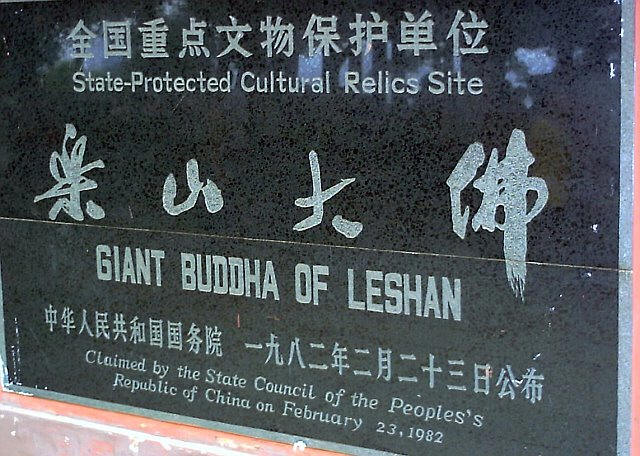
Leshan: One of the plaques marking the
location of the Giant Buddha of Leshan.
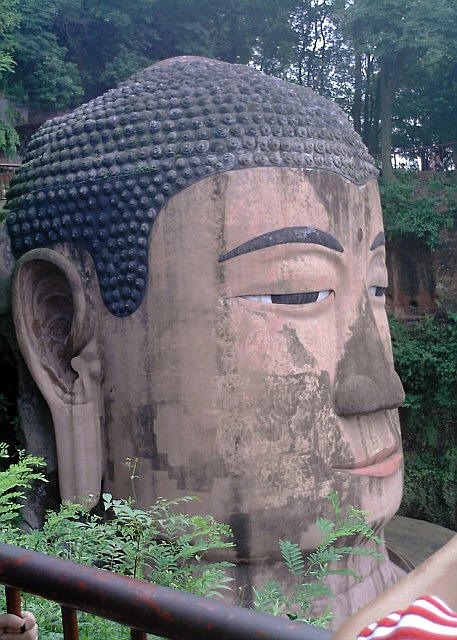
Leshan: Head of the Giant Buddha; up
close.
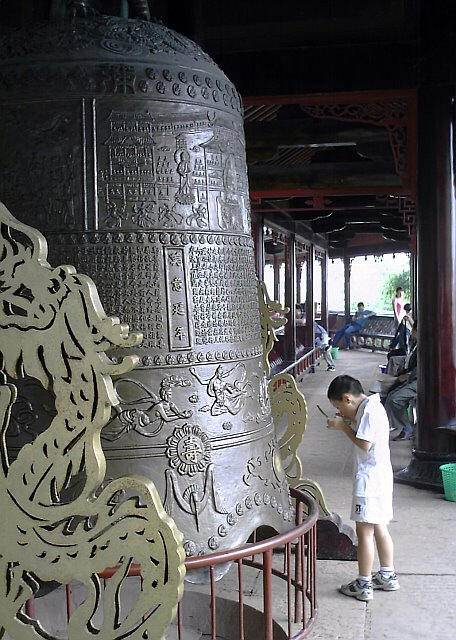
Leshan: This bell rings to mark the rising of
the sun every day... at least in ancient times it did. Today people ring it
as they please while lingering around the top of the hill where the head of
the Giant Buddha is located.

Leshan: Monk Haitong lived in this cave
during the construction of the Giant Buddha.
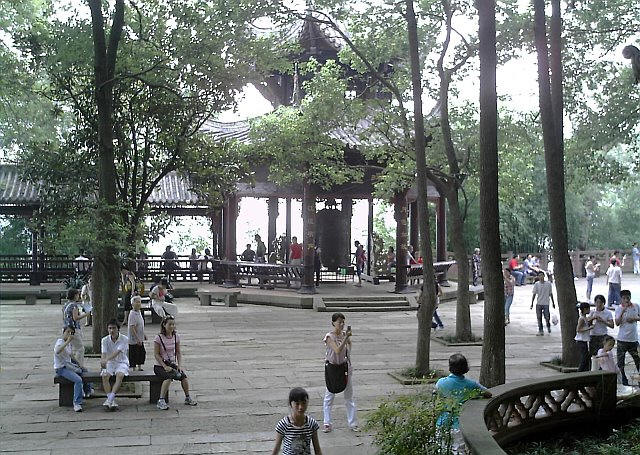
Leshan: Rest area on the grounds that
surround the head of the Giant Buddha.

Leshan: Close up of the Giant Buddha's left
ear and the hole into what?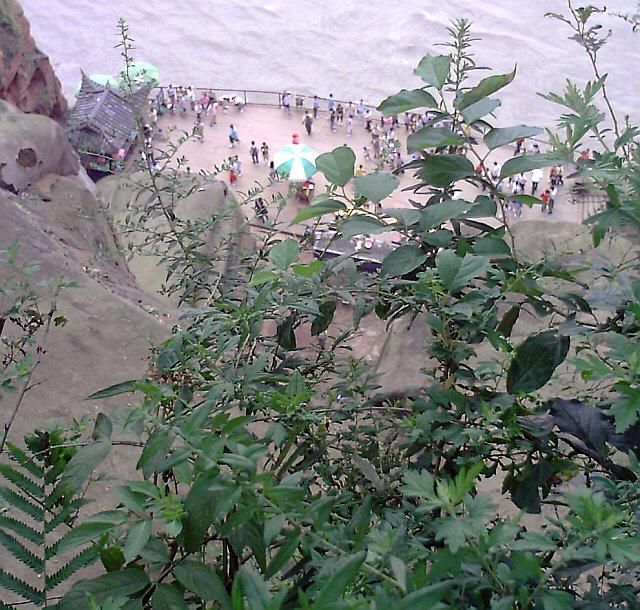
Leshan: Looking down on the observation
platform at the foot of the Giant Buddha.
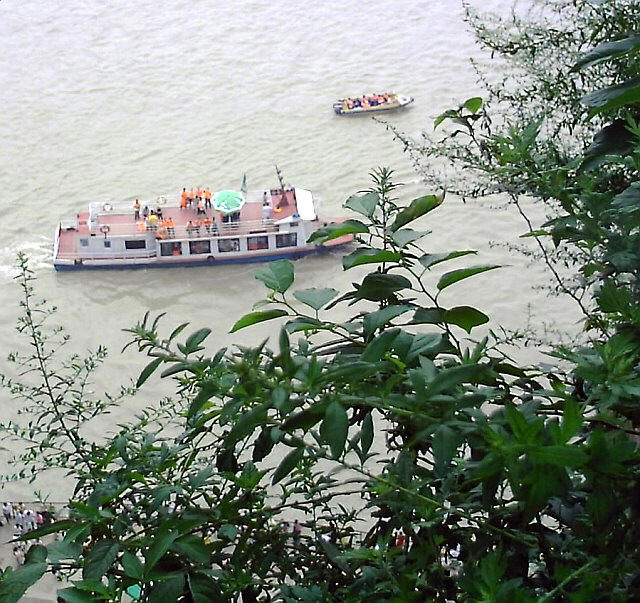
Leshan: View of a tourist boat lingering near
the feet of the Leshan Giant Buddha statue.

Leshan: View of the Grand Buddha from my
eighth floor room in the Jia Zhou Hotel on a clear afternoon. This clarity
is unusual. Haze usually makes it difficult to see the cliffs clearly.
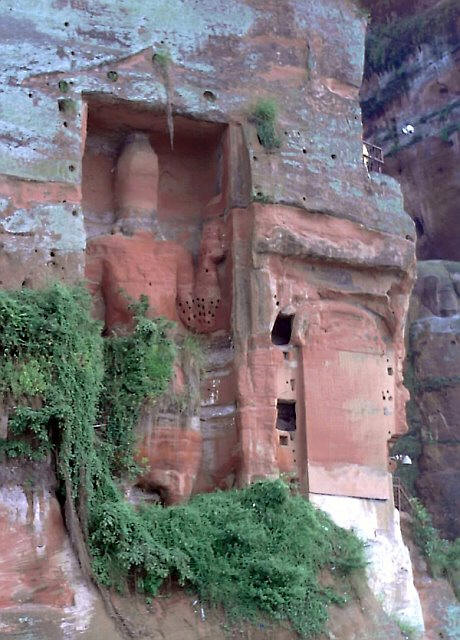
Leshan: Smaller statue carved in the cliff on
the left side of the Giant Buddha as seen from the tourist boat that took us
to the foot of the Giant Buddha.
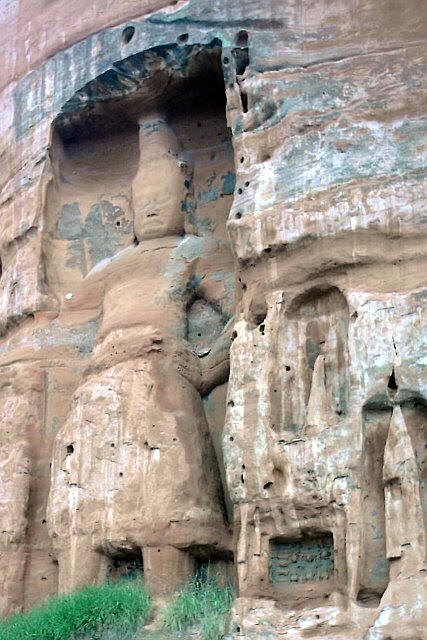
Leshan: Smaller statue carved in the cliff on
the right side of the Giant Buddha as seen from the tourist boat that took
us to the foot of the Giant Buddha.

Leshan: People on the long steep stone
stairway down to the viewing platform at the base of the Giant Buddha statue
as seen from the tourist boat that took us to the foot of the Giant Buddha.
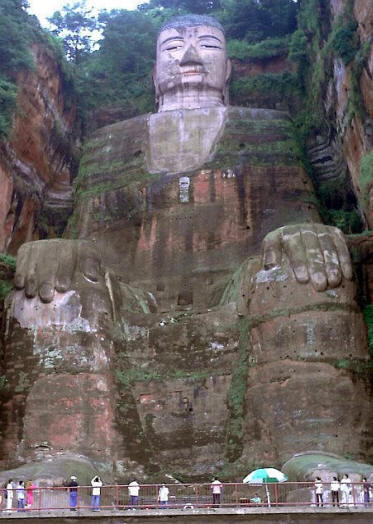
Leshan: View of the Leshan Giant Buddha from
the deck of the tourist boat.
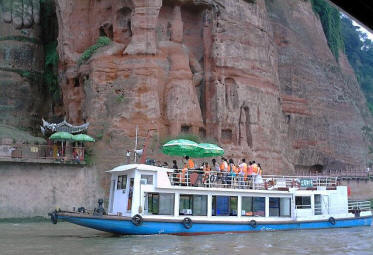
Leshan: A second tourist boat maneuvers in
front of us for a closer look at the Giant Buddha statue.
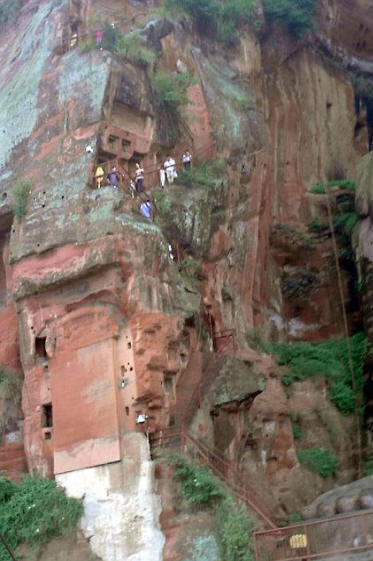
Leshan: People on the long steep stone
stairway down to the viewing platform at the base of the Giant Buddha statue
as seen from the tourist boat that took us to the foot of the Giant Buddha.

Leshan: From some river vantage point it is
reported the contours of the mountains resemble a giant reclining Buddha
giving rise to the traditional description: "The mountain is the Buddha; the
Buddha is the mountain." Stretch my mind as I might from every point along
our river cruise, the only thing I saw reclining were the hills themselves.

Leshan: This dock sits near the South
Entrance to the Buddha Cultural Park. A very loud one cylinder engine
pounded away shattering the otherwise serene peacefulness of the place. The
loud staccato noise followed me far up the steep trail leading to the WuYu
Monastery. once inside the cloistered walls the noise disappeared. I'm
wondering if the noise is being created intentionally.
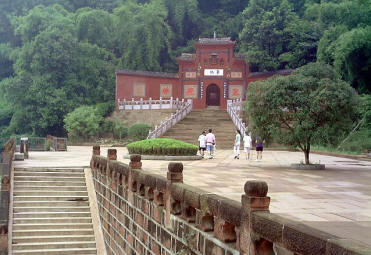
Leshan: South Entrance to the Buddha Cultural
Park. A steep trail leading to the WuYu Monastery had stone carvings on the
cliff walls hugging the trail.

Leshan: This sign seems incongruous in the
South Entrance to the Buddha Cultural Park considering the very loud
staccato noise that followed me far up the steep trail leading to the WuYu
Monastery. once inside the cloistered walls the noise disappeared.
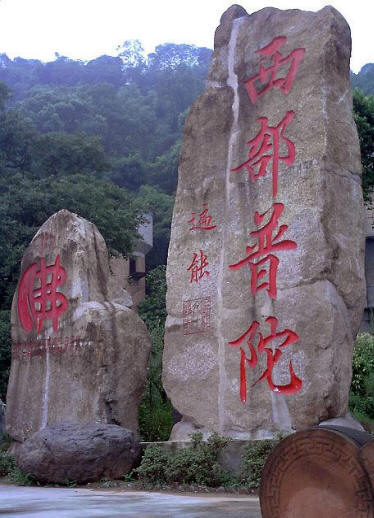
Leshan:
Huge stone marker near the South Entrance to the Buddha Cultural Park.
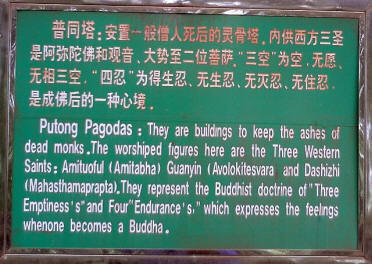
Leshan: Sign near the South Entrance to the
Buddha Cultural Park.
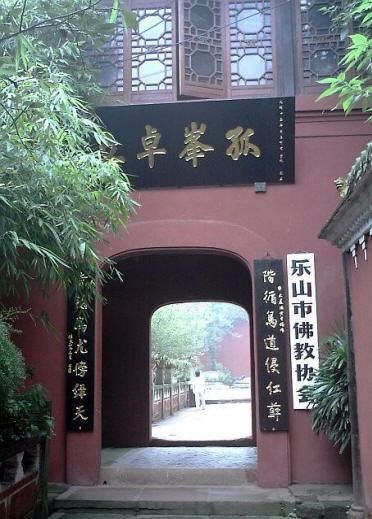
Leshan: One of the gates into the Wuyu
Monastery.

Leshan: Lions guard an entrance into a temple
at the Wuyu Monastery.

Leshan: Historical information about
Buddhism.
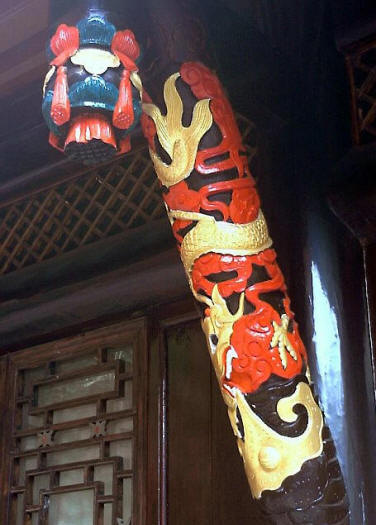
Leshan: One of the colorfully painted braces
holding up a roof at the Wuyu Monastery.
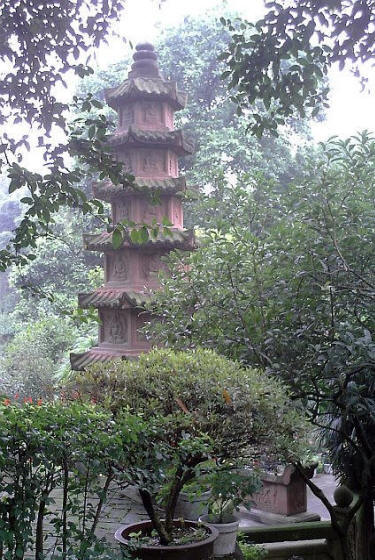
Leshan: Memorial pagoda in a peaceful
meditation garden at the Wuyu Monastery.
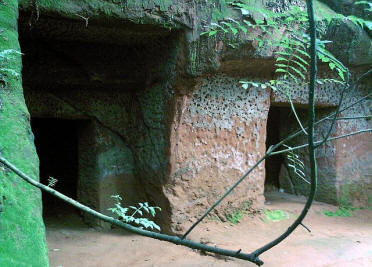
Leshan: A couple of the caves inhabited by
monks in ancient times.
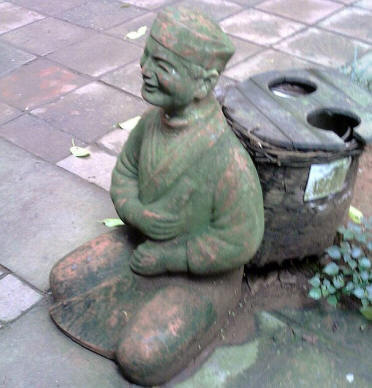
Leshan: Trash cans like this one are found
all over the park.
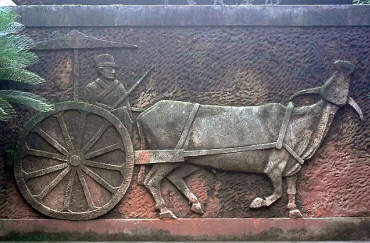
Leshan: Bas relief sculpture on one of the
walls along the main path in the Buddha Cultural Park.
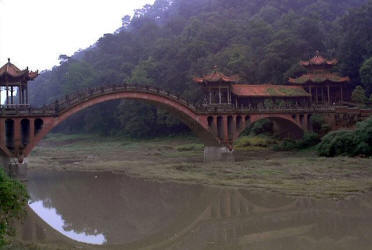
Leshan: Picturesque bridge across the river
near the East Gate of the park.
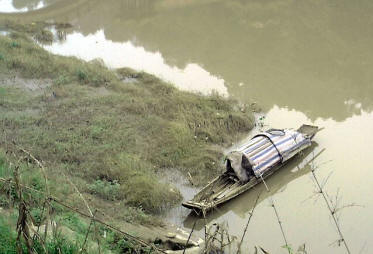
Leshan: Picturesque boat in the river near
the East Gate of the park.
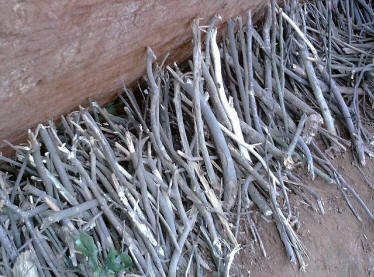
Leshan: Pilgrims install sticks to prop up
the mountain near the East Gate of the park. I don't know the story, but it
looks like people are adding their one little stick to all the others to
hold up the mountain.
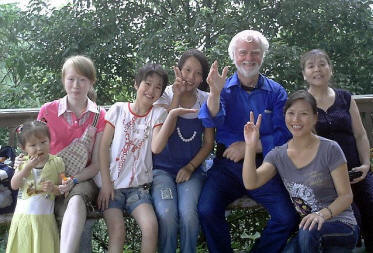
Leshan: Fred and friends pause for a group
photo after an extended English "lesson."

Leshan: This little girl absolutely would not
get within grabbing distance of the scary creature her family so much seemed
to enjoy. Grandmother provided the necessary protection that allowed me to
get this one through trickery.

Leshan: One of the hundreds of Buddhas
memorialized throughout the park.

Leshan: Scary guardian near one of the major
temple entrances.
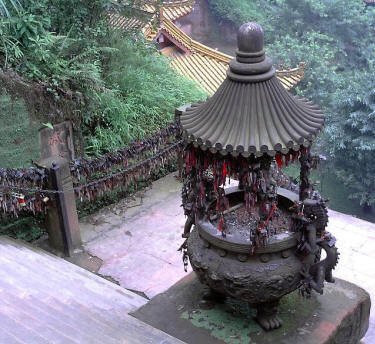
Leshan: Incense burner near the bottom of the
wide stairway. Notice the thousands of locks hanging from the chain in the
background and from various places on the incense burner.
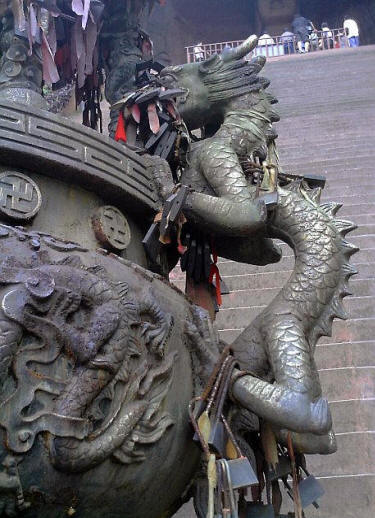
Leshan: Details on the incense burner covered
with locks near the bottom of the wide stairway.
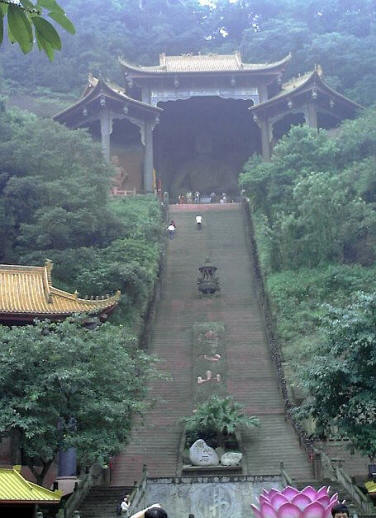
Leshan: Shot of the temple complex near the
bottom of the wide stairway.
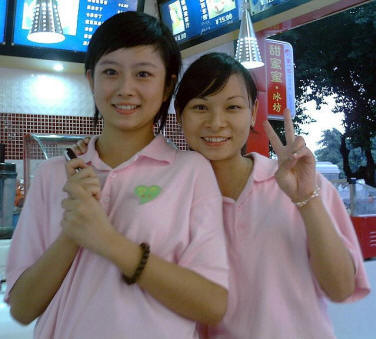
Leshan: I stopped in the Sweety cafe for
kabobs one evening and acquired two more English students. The one on the
right insists her English teacher gave her the name, Cherry. The one on the
left begged me to give her an English name, so I did: Shirley. I couldn't
believe how emotional this insignificant event became for the poor child. I
visited the place several more times. The last time I left she broke down
with eyes brimming.
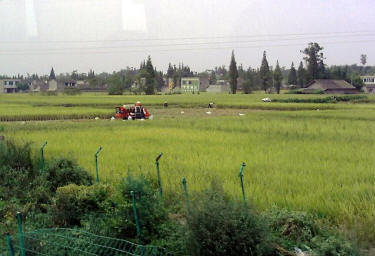
Leshan: We passed an endless sea of farmlands
on the bus trip to Leshan from Chengdu. While vast areas of rice could be
seen, companion planting dominated the scene. Many of the rice fields were
being harvested; some by mechanical combines, other by old traditional hand
methods.
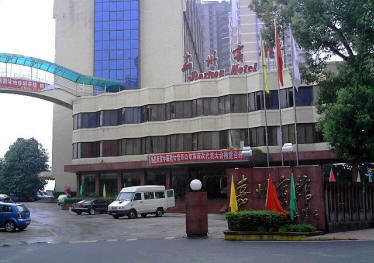
Leshan: Entrance to the three star $43 Jia
Zhou Hotel where I stayed.
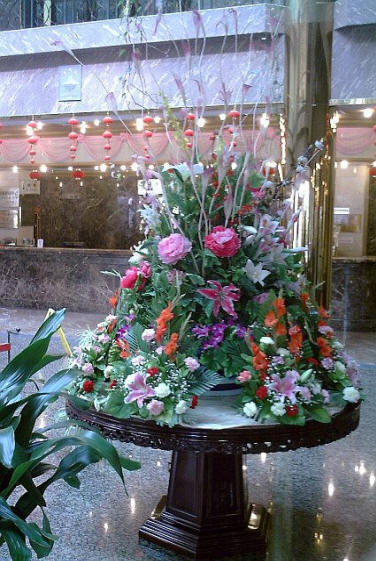
Leshan: Floral arrangement in the lobby in
the Jia Zhou $43 three star hotel... which deserves four stars.
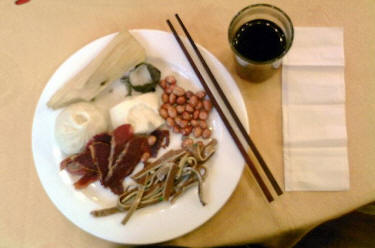
Leshan: Every day this is the "breakfast"
that would start my day. The brown leather shoelaces are baked bean curd.
Fried peanuts are a regular fare at breakfast. The small dark leaf wrapped
item is sticky rice flavored as the chef sees fit each day. The pile of
chipped beef became my sole source of morning protein. Two kinds of soft
buns, one filled with hash added unwanted carbohydrates to my morning feast.
A Chinese corn husk wrapped "Tamale" is actually a spongy cake like food,
slightly sweet. The glass contains a reasonable imitation of coffee; no cups
in this hotel. A knife and fork were offered the foreigner until I regularly
chose the sticks like everyone else.
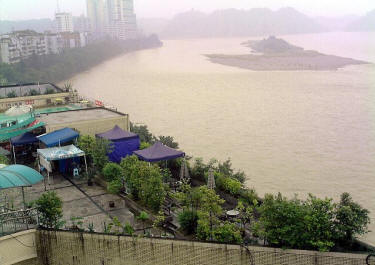
Leshan: River view from my eighth floor room
in the 3 star $43 Jia Zhou Hotel.

Leshan: One of the monumental sculptures in a
large plaza across the street from the hotel. Every night the plaza exploded
into a wild dance party with multiple groups competing for attention.
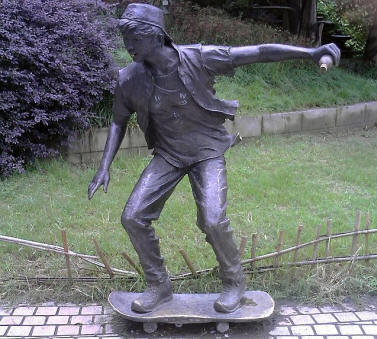
Leshan: Sculpture along one of the walkways
through a maze of shopping stalls leading over to the hotel.
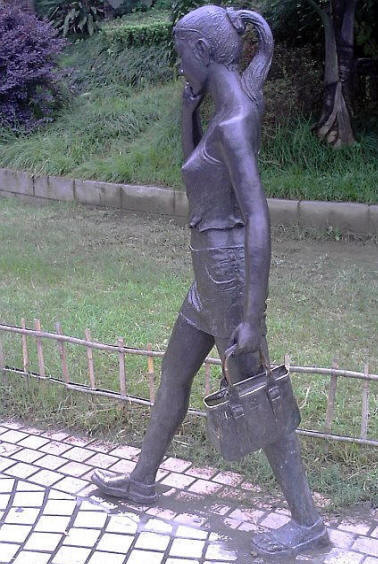
Leshan: Sculpture along one of the walkways
connecting a happy little park over to the hotel.
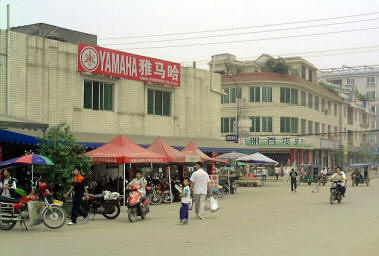
Leshan: I love riding public buses in foreign
countries. At the end of the #10 city bus I found this typical compact
community of JuZi. This is the main street of town.
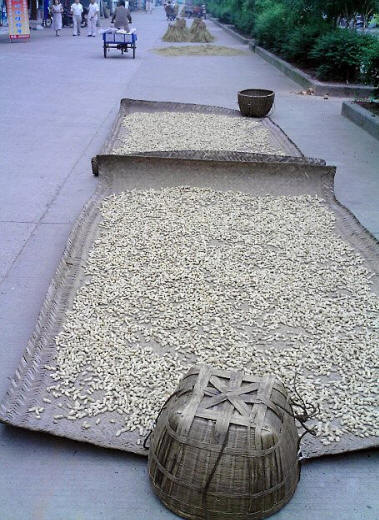
Leshan: At the end of the #10 city bus I
found the typical little community of JuZi. Obviously a farming hub, I
spotted grain drying on the street down the main drag through town.
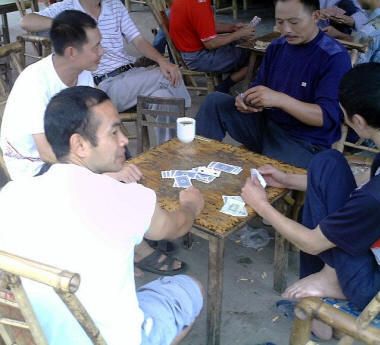
Leshan: At the end of the #10 city bus I
found the typical little community of JuZi. Obviously a farming hub, several
open front cafes serve as social centers for card players.
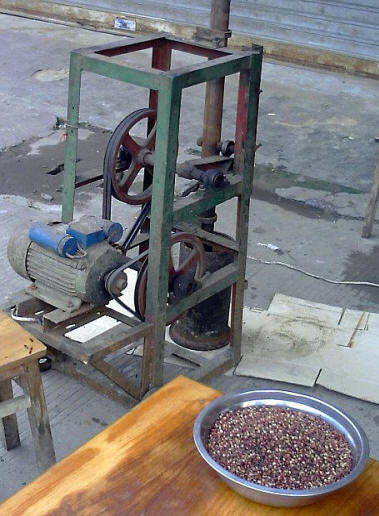
Leshan: Walking the streets of JuZi I could
hear a block away the pounding of some machine. Then I came upon this
primitive pepper mill pounding away while the operator's wife roasted more
raw peppers in preparation for the grinding.
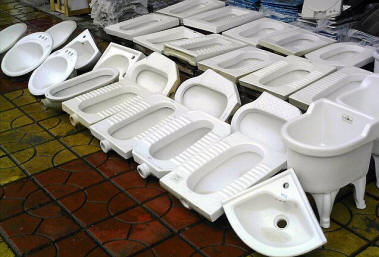
Leshan: Away from the main street I found
this plumbing shop with its display of bathroom fixtures, toilets... Chinese
style, naturally.

Leshan: During my daily walks around town I
discovered many farmers markets like this one.
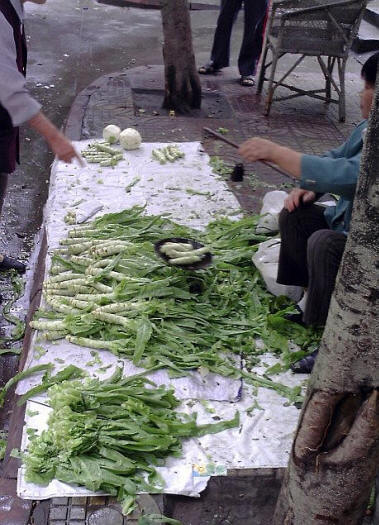
Leshan: Some of the infinite variety of
"weeds" offered for sale in the many farmers markets I discovered around
town.
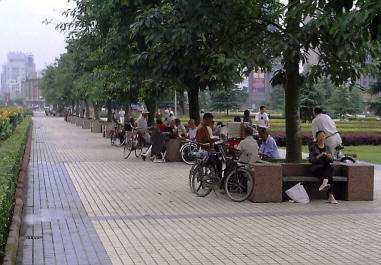
Leshan: Sidewalk around the Times
Square Plaza are enjoyed by strollers and joggers alike.

Leshan: Sidewalk benches around the
Times Square Plaza are a popular place for a friendly game of cards
with
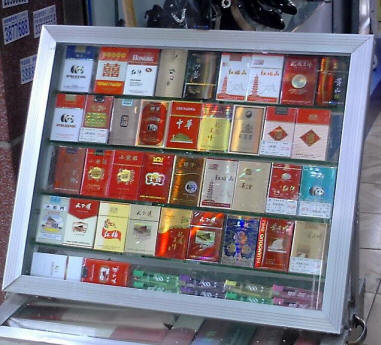
Leshan: Cigarettes are a government
monopoly in China. Prices vary from 3 to 70 Yuan, or 45 cents to
$10.50 per pack of 10 coffin nails. Creation of attractive, elegant,
shiny packaging must be a major enterprise in the country. Shame on
you China.

Leshan: I have often joked that Chinese chefs
must be blind because they always leave bone fragments in the food they
prepare. I watched this butcher as he chopped away at a chicken making bone
splinters as fast as he produced one or two inch pieces of the bird,
oblivious to the location of joints. So, the butcher is the bone splinter
culprit, not the cook.
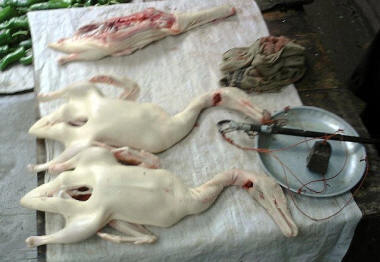
Leshan: Here are the makings for "Tongue of
Duck" with plenty left over to make a pot of duck soup.
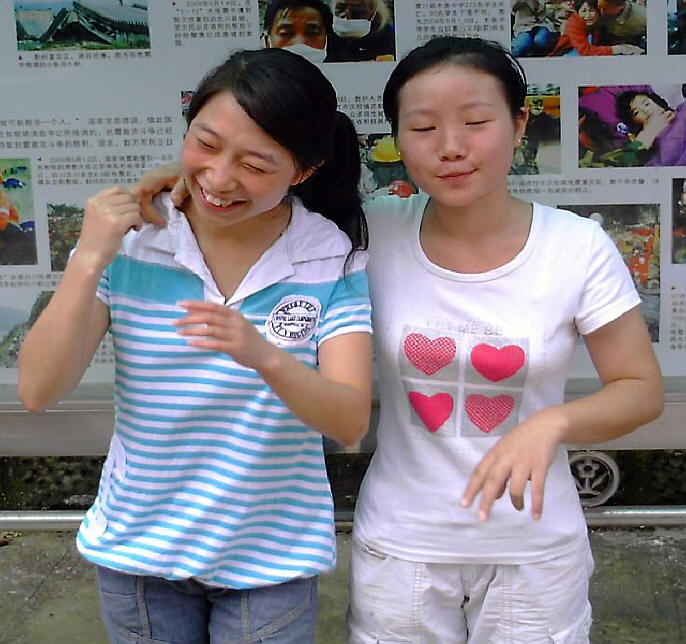
Leshan: Dinah translated the literal meaning
of eight Chinese characters chiseled into a stone boulder installed in front
of her college and attempted to decipher the intention of the author. A
teacher came by and explained the meaning in English: "Gather as much knowledge as you can
so you bring no shame on yourself."
|
  29
August 2008 29
August 2008
Blessings from the Giant Buddha of Leshan China,
Monumental, is the first word that comes to mind as I stand
eye to eye with the head of the enormous
Giant Buddha of Leshan. For over a thousand years it has
reminded believers to anticipate the arrival of a "redeemer"
in the far distant future who would teach mankind how to
control its cravings and enjoy unbounded bliss free of
suffering. These ancient Buddhist teachings bear an
interesting resemblance to old Jewish prophecies. Most of
the throngs standing around me are in a festive mood,
cameras clicking away, children noisy in their rambunctious
play, ice bonbons (Popsicles) passing from brother to
sister, security guards dressed as Buddhist monks or
brothers watching benignly, leather faced octogenarians
gazing in amusement or reminiscing about the unrealistic
promises of youth.
Peering over the edge down to the base of the statue, I am
struck by the similarity with that Egyptian
Abu Simbel colossus at Aswan and the now destroyed
Buddhas of Bamyan in Afghanistan. People do the most
astounding things when intoxicated by the ecstasy of their
religious beliefs. During my undergraduate days I remember a
professor asserting: "The history of the world is the
history of its technology." Now older, wiser and more widely
traveled I must insist on adding religion to the conclusion.
In every culture of which I have any knowledge, in every
period of history I have studied, religious beliefs have
played a major role in people's lives. Never mind the
objective evidence for the validity of the beliefs is always
lacking, people appear compelled to concoct outrageous myths
to complete their understanding of the world they know. The
policy makers in China seem to know this better than the
governments of most other nations around the World.
For the past week I have been in a small town 175
kilometers south of Chengdu. I'm staying at
the underrated three star $43
Jia Zhou Hotel. Below my eighth floor window flows the
Dadu River. Not more than fifty meters away, I can see a few
small boats glide slowly up and down the coffee brown gentle
turbulence. The water craft are picturesque, but the real
stars of the river are the frequent gangs of swimmers who
enter a kilometer up stream from a wharf and float past my
window leaving the river at another wharf one or two
kilometers further on down stream. A few choose to end their
float on the shores of a small island sitting in the middle
of the river with the Leshan Giant Buddha cliffs in the
background. The performance is repeated frequently
throughout the day; sometimes by a lone swimmer, but more
often by groups of six to twenty hardy souls wearing
floatation vests and bright swimming caps. The first time I
saw a cluster of colored "balls" bobbing past my window I
guessed they might be unusual flotsam, wobbling aimlessly as
they passed by about twice as fast as I can walk.
After a week in the hotel I discovered the famous
Leshan Giant Buddha occasionally is visible from my
river front room during brief periods in the afternoon when
the haze lifts. Seventy-one meters tall and carved into a
red sandstone cliff at the edge of a river, it is the
largest sitting Buddha sculpture in the World. Around the
site of the sculpture are numerous Buddhist temples and
monasteries. At the North Gate ticket window I learned they
grant ancient ones like me, free entry into the park. Those
under seventy pay a 50 Yuan entrance fee, about $7.50. The
path up to the main attraction contains numberless
commemorations of Buddhist monks who led exemplary lives and
who now, themselves are considered Buddhas. Anyone in a
hurry could reach the top of the hill for a look at the
curly head of the giant in a half hour. I took much longer
as I lingered here and there to read the numerous plaques
containing historical notes, to admire the handiwork of long
forgotten sculptors, to capture photographic images of the
wonders and to just enjoy the serenity of the
place. (Don't miss the additional "overflow" collection of
pictures on the
appended page.) My first impression of the Giant Buddha of Leshan was
well... BIG.
The next day I entered the park from the South Gate and
explored the pathways in that area leading to more temples,
caves and monasteries. The hill is rich with ancient
cultural artifacts left by Buddhist monks during the past
two thousand years. Wandering the secluded grounds of the
sprawling Wuyu Monastery hidden in the hills above the Giant
Buddha, I found it easy to imagine century after century of
brothers walking among the shady trees, pagodas and
inspiring vistas contemplating... nothingness. My own empty
mind played with a wordless sense of that ultimate reality.
So much serene beauty, so much silence, so many reminders of
the countless numbers of men who devoted their lives to
understanding and practicing the ideas discovered by
Siddhartha Gautama more than twenty-five hundred years
ago left me with a sense of calm, of suspended awe.
Traveling alone as I do gives me a lot of time to think in
the cloister of my own mind. This monk needs no walled
enclosure, no monastery to find the peace of seclusion.
Unorthodox perhaps, but different strokes for different
folks.
LeShan and EmeiShan are among the most revered
devotional sites in all of the Buddhist tradition.
According to
historical records, the first Buddhist temple in China
was built in the beautiful surroundings of nearby Mount Emei
in the first century, shortly after Buddhism was introduced
from India. I had never even heard of the place before
coming to the country this time. That realization is a good
reminder none of us can experience everything and that even
those with vast exposure to what the world has to offer must
be content with the knowledge he has but sampled a tiny
fraction of everything. Global generalizations are always
tainted by the preponderance of the invisible unknown.
Naturally, many of the people near my eminent presence here
on the mountain found me much more interesting than a crummy
thousand year old statue hacked into a crumbling cliff. I
kid you not, here we are in the presence of one of the
World's true cultural treasures and people are gathering
around me to study my funny camera, my white beard, my round
eyes... and god knows what else! Parents try to act
nonchalantly while they encourage the kids to provoke the
beast with primitive "hello's," "Wha yo fra?" or a tentative
"nee ha." Because the English language is now being
taught at all levels throughout the country, it is
impossible to be far from someone who displays an anxious
eagerness to practice his or her limited capability...
usually a her. If the kids inexcusably happened to be more
interested in something else, the parents commonly nudge the
little ones pointing at me so they don't miss this once in a
lifetime opportunity to see one of those "foreign
devils from the sea" grandma mentions with a quivering
voice.
While walking one of the downtown streets here in
Leshan I paused to watch the activity in a beauty
salon. To my surprise, three of the four women
receiving attention from the beauticians were having
their hair dyed! I guess that explains why one sees
so few grey or white haired women. Several English
speaking people with whom I managed to develop a
rapport have confided my appearance reminds them of
Mister Christmas... Santa Claus. I suppose the
little ones even here in this nominally secular
country might experience awe facing that mysterious
fat, bearded bringer of gifts, exotic happy seasonal
music and tasty tid-bits. On my last trip to the
country during December 2004 I found the ubiquitous
strains of Western Christmas carols complete with
religious lyrics incongruous to say the least.
China is a beautiful land; some parts are
excruciatingly gorgeous, but with a little
persistence one can still find pockets of squallier.
For the most part however, even the poorest areas
are neat and clean with residents who seem to be
enjoying their simple lives. Beggars are practically
nonexistent: I saw only one during my 12 day stay.
Frankly, it is the less affluent parts of the
country which I find most fascinating.
If you want excitement, come to China. In this
little tourist town of Leshan something happens
everyday. Major events like a wedding reception at
the hotel are sure to require fireworks. A big hat
box full of giant firecrackers all linked together
is set off, creating a monstrous sound like a
truckload of bowling balls being dumped on a wooden
platform. The first time I heard the sound I thought
a building had collapsed!
The city sits on a broad flat plain with lots of
level streets and sidewalks. Here in the city of
Leshan evenings are for strolling along the river
walk or joining one of the dance classes in the
small plaza next to the hotel or pausing to enjoy
musicians hired to herald a new store opening. There
is always something to entertain people out to enjoy
the evening cool along the crowded downtown streets.
I walk a lot and find most odors along any of the
back ways are distinctly "Chinese." Next time you
visit a major Chinatown somewhere in the United
States notice the smells. That is what I whiff much
of the time here... that and an infinite variety of
other unique fragrances produced by boiling oils,
chopped weeds, a welder's torch, roasting red
peppers, burning incense or any number of other
sources. My walks are a veritable torrent of unique
aromas.
The country continues to build high rise housing
structures at a dizzy rate. Each is designed like a
self contained town with shopping facilities
integrated into the buildings. Need a bag of spongy
buns? Just run down stairs to one of the grocery
stores on the ground floor. Planning a social
gathering with friends? Yep, it can be reservations
at one of the several restaurants next to the
grocery stores. Shoes need fixing, a new dress for
the party, some plumbing supplies? Same answer. It
is all very convenient. And, if you don't find
exactly what you want in any of the stores in your
neighborhood, just hop on a fifteen cent bus to
anywhere in the city for what seems like an infinite
variety of alternatives.
Smokers practice their destructive addiction
anywhere they wish and puff away without regard for
the health concerns of anyone! Every part of my
hotel room, dining room chairs and table cloths show
the costly physical damage caused by careless
smokers. The economic impact must be enormous!
Cigarette sales are promoted with glittering
packaging by the central government. It has a
monopoly and apparently is a major source of
revenue. Prices for an attractive package of coffin
nails range from 2 to 70 Yuan (30 cents to over
$10). Most packages do not carry health warnings. To
be fair, quite a number of business establishments
prohibit smoking in all or a part of their stores
and there is no smoking in cabs or buses. As far as
I can tell there is no organized anti-smoking
campaign in China yet.
Fortunately, I have been approached several times
by people willing to help me with my struggling
Chinese. Hanyu or
Mandarin, as it is known in the West is a very
difficult spoken language, requiring students to not
only memorize phonetics for a word, but also the
unique "melody" associated with each idea! Since
entering China five weeks ago I have managed to
remember the
Pinyin representations for a number of useful
phrases, but few people can figure out what I am
"saying" as I sing the phonetics to a mangled
version of the correct song. To understand my
difficulty with learning the dominant spoken
language of China, imagine trying to sing the words
of one well known English language song to the
melody of another; for example "Row, row, row your
boat" to the tune for "Twinkle, twinkle little
star." It just doesn't "feel" right! Get either
wrong and you have a garbled mess!"
The
First Emperor Qin Shi Huangdi around 200BCE
recognized the problems created by the hundreds
of spoken languages throughout his empire and
brilliantly, if ruthlessly ordered everyone
across the land to use a single written
representation of ideas for which there were so
many different spoken versions! Too bad he
didn't order them all to speak something like
modern English as well.
Except for that one session in Xi'an
in the dark dingy cavernous third
floor WangBa where I wrote in
explicit detail about the two main
"forbidden" subjects, I have been
totally unaware of any interference
with things I put in my postcards.
Looking back, I now suspect even
those problems might have been an
artifact of the screwy session
control software being used by the
establishment, rather than
governmental intrusion. But, who
knows? Internet cafes here in Leshan
are more respectable, usually
located at the street level and
smaller with good lighting.
On the political front, my friend
Timothy alerted me to a recent
widely reprinted article by Robert
Perry,
How the Republicans Win. A knee
jerk reaction after quickly skimming
the work suggested it contained more
of what everyone already knows about
the disastrous Bush presidency.
Looking for credible conservative
reactions to the article I checked
for
reviews of Parry's books at
Amazon.com. While the author's
conclusions might surprise no one, I
found the huge catalog of supporting
evidence cited in the article
shocking. Every American,
conservative or liberal needs to
consider the implications of this
investigative reporter's
revelations. As I have long
suspected, our democracy is in
peril! Every apathetic citizen is an
unwitting co-conspirator. Peace
Fred L Bellomy
PS: My ever vigilant friend Geno upon reading the
tale of eating apples like a horse in my last
postcard, pointed out there are hazards to consuming
too many apple seeds! Amazing as his assertion
sounds, I confirmed with a little research chronic
overzealous apple
seed munchers could conceivably exceed the half
lethal dose for that innocuous food. However, even
water has a
half lethal dose it turns out (over six gallons
in one sitting)! The apple seeds, if chewed well can
produce
Cyanide! None of the citations I found quoted
the level of a deadly dose and most implied an adult
would need to chew up seeds from more apples than
anyone could reasonably be expected to consume in a
single sitting. Still, here is some more amazing,
astounding knowledge I didn't have until that
Chinese kid and I chomped away under a shady tree
inside an obscure Buddhist monastery deep in the
mountains of central China. Every day it is
something new... if I am lucky.
PPS: I leave in a day or two for nearby Mount Emei, more
climbing and study of Buddhist traditions. FB

Leshan: View of the Giant Buddha from
the deck of the tourist boat.
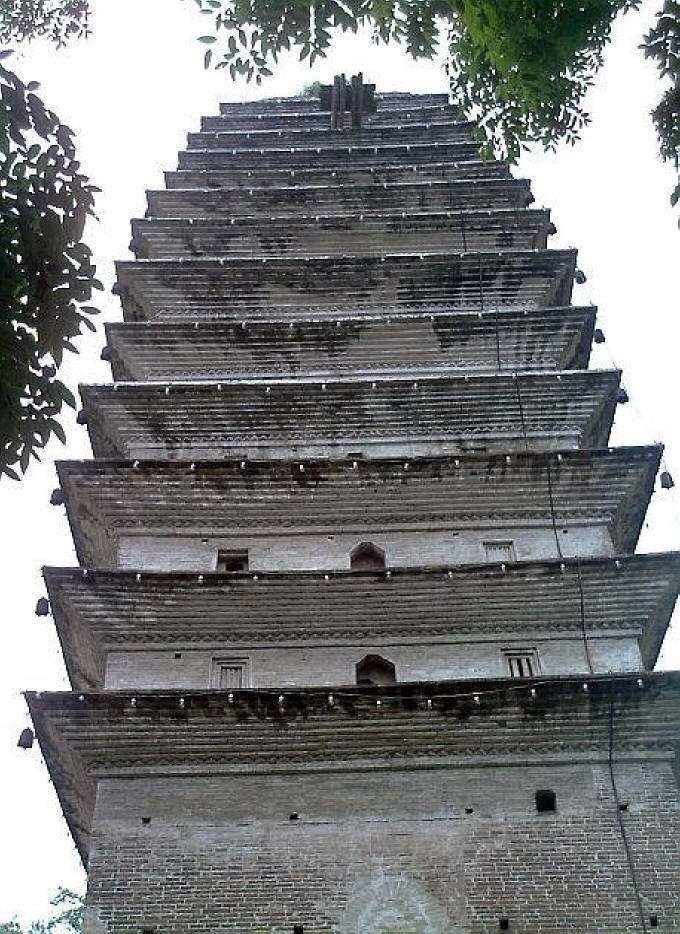
Leshan: The Lingbao Pagoda. It is
visible from many locations throughout the city across the river.
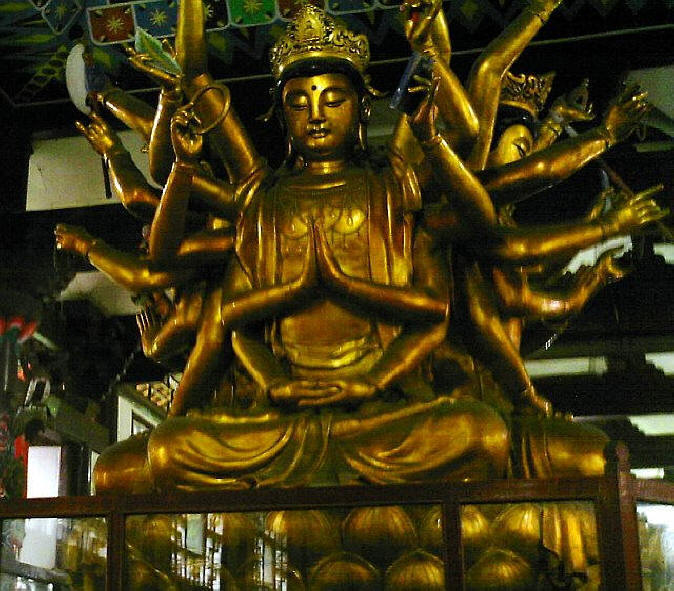
Leshan: Forbidden photo inside the
Temple of a Thousand Buddhas at WuYu Monastery. This is the Buddha
with a thousand arms that sits at the center of the temple. My
little "spy" camera came in handy here. Actually, I think the
prohibition is only applicable to flash cameras.
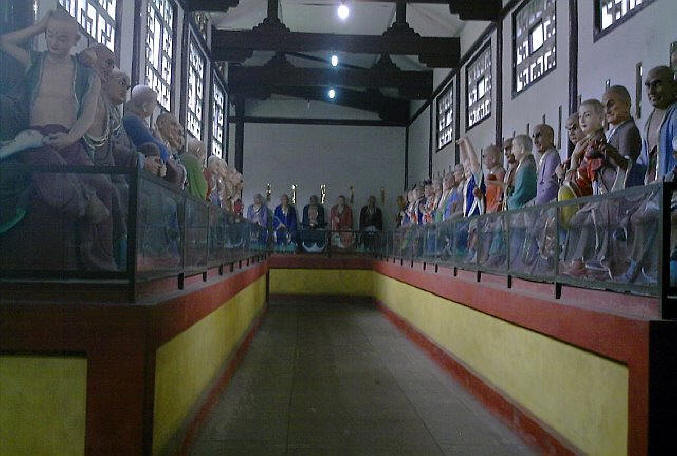
Leshan: Some of the inhabitants in
the Hall of a Thousand Buddhas at the Wuyu Monastery. Photo thanks
to my tiny, silent, flashless camera.
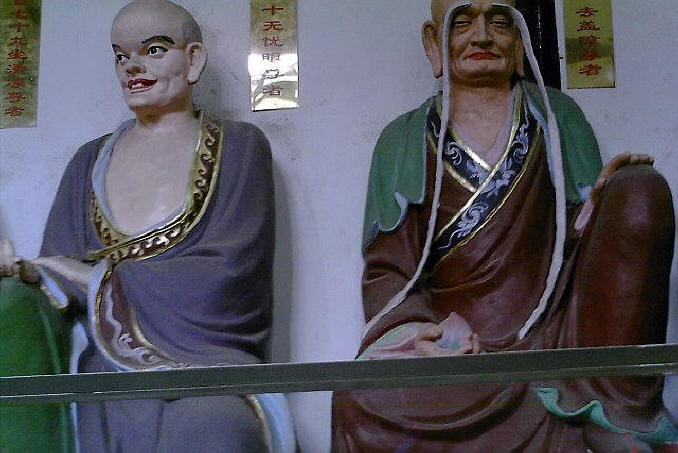
Leshan: Some of the inhabitants in
the Hall of a Thousand Buddhas at the Wuyu Monastery. These two are
particularly lifelike.
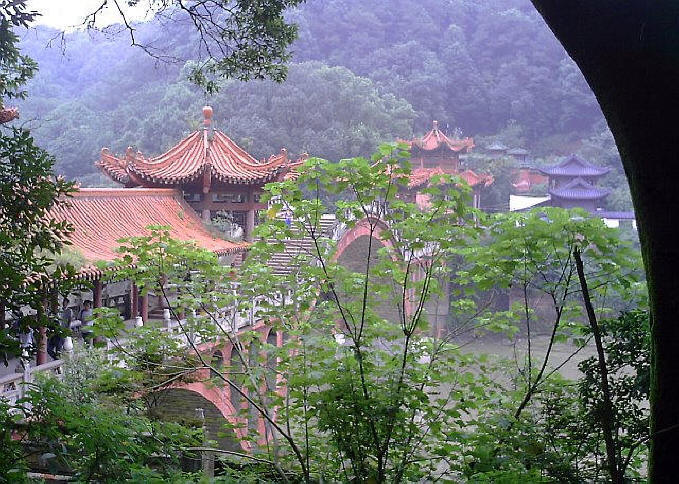
Leshan: Bridge across the river near
the East Gate.

Leshan: At the top of the bridge
these folks took a special interest in me and my activities. The guy
was trying to take my picture.
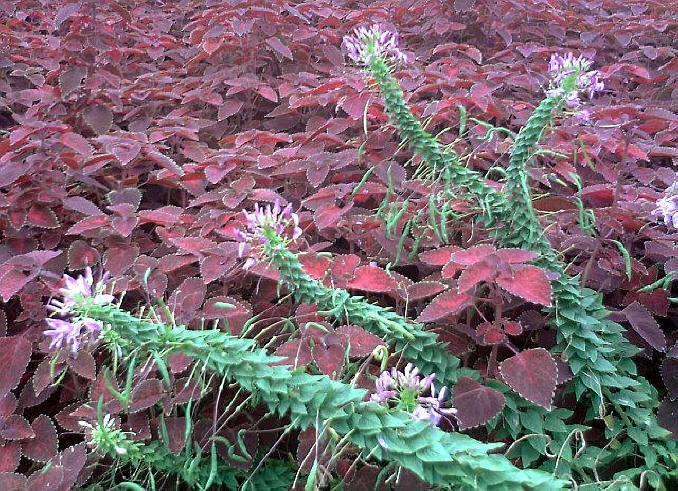
Leshan: Flowers carpet an area around
the extensive grounds of the Times Square Plaza.

Leshan: More examples of flowers used
to landscape the area around the extensive grounds of the Times
Square Plaza.
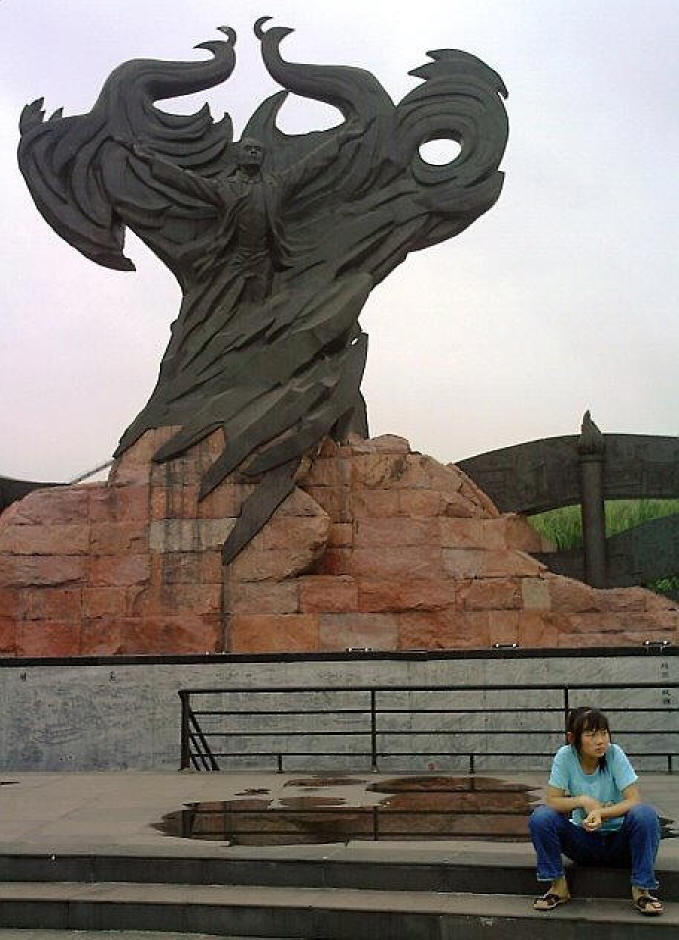
Leshan: Close up of the focal point
sculpture on the grounds of the Times Square Plaza.

Leshan: I found this bright shiny
steel sculpture particularly appealing. Part of the scattered
sculpture garden in the Times Square Plaza, it reminds me of the
Little Mermaid near Copenhagen Denmark.
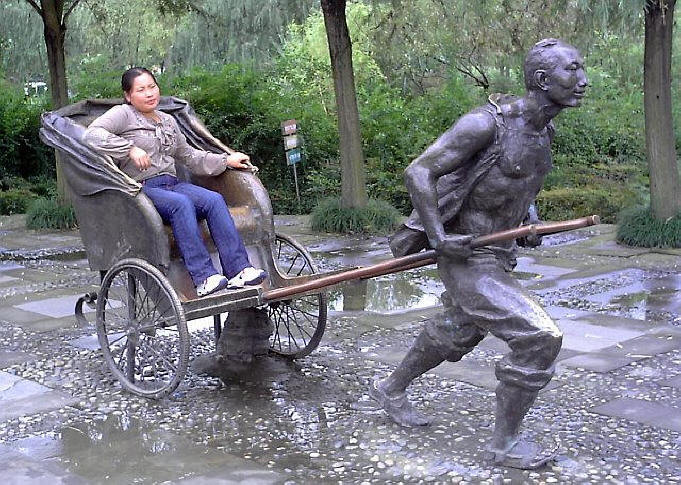
Leshan: Part of the scattered
sculpture garden in the Times Square Plaza.
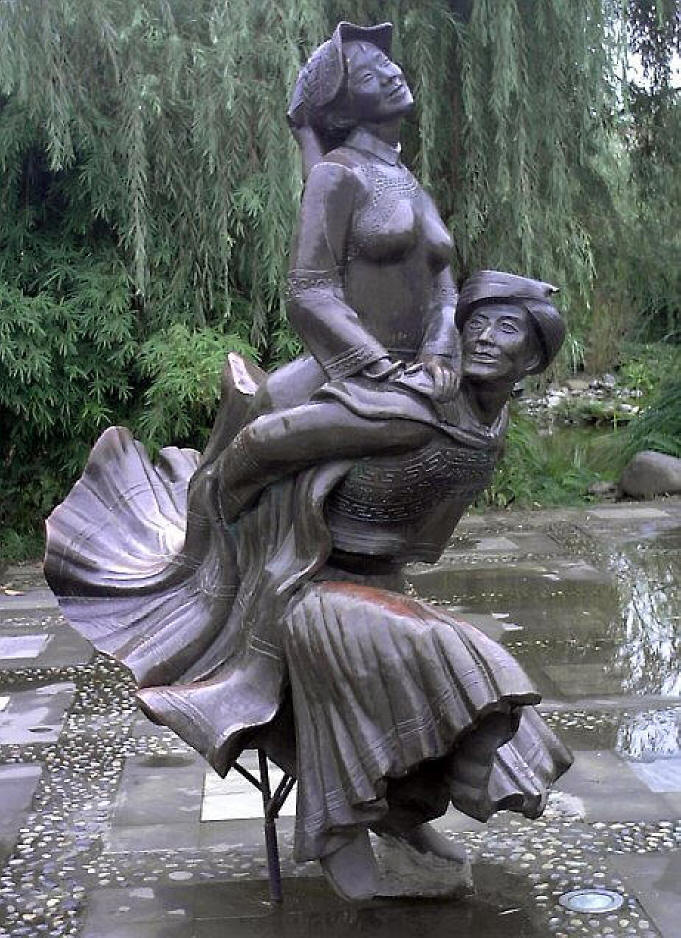
Leshan: Part of the scattered
sculpture garden in the Times Square Plaza.
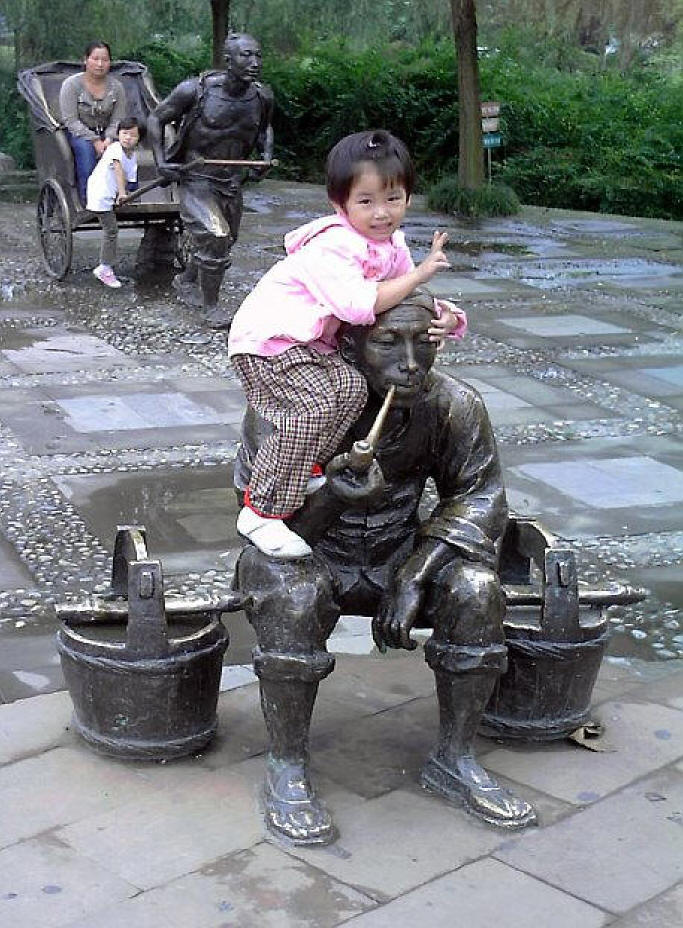
Leshan: Part of the scattered
sculpture garden in the Times Square Plaza. This kid appointed
herself my unrequested photographer's model and followed me around
putting herself in every scene I showed some interest in.
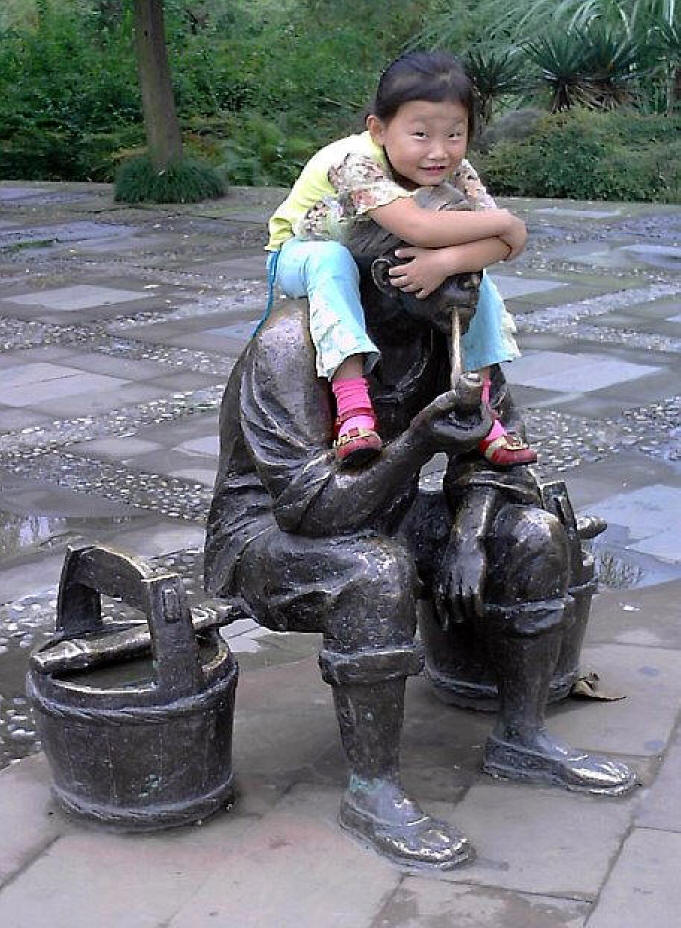
Leshan: Determined to not be outdone
by her cute little sister, this charmer worked hard to attract the
attention of my camera in the Times Square Plaza sculpture garden.
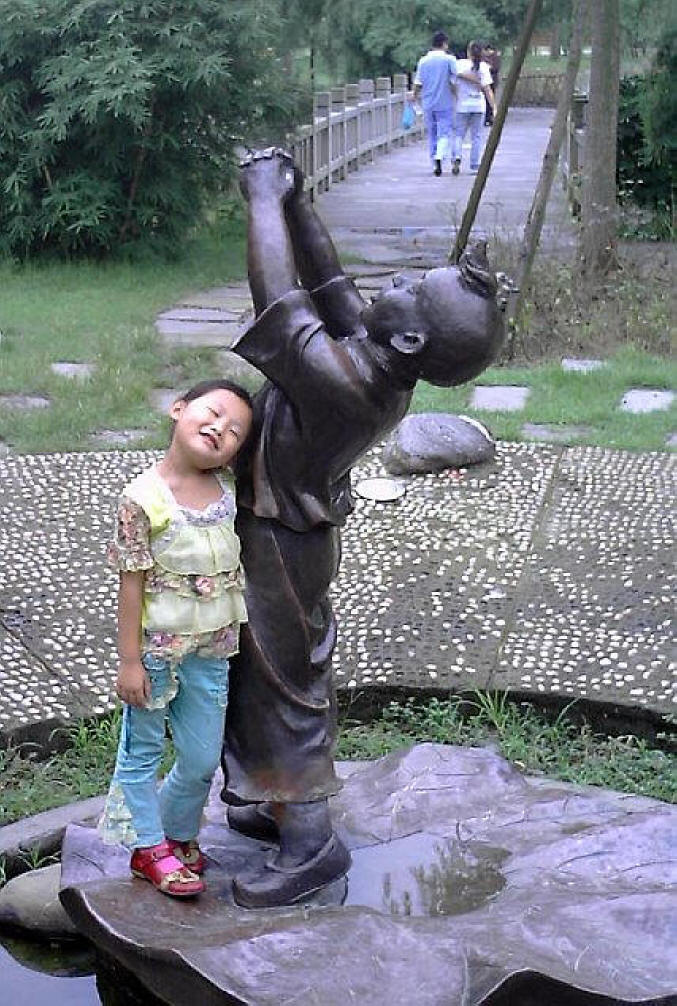
Leshan: Everywhere I went in the
sculpture garden this little kid posed for my camera. I must wonder
if her parents encourage such behavior. I found it delightful.
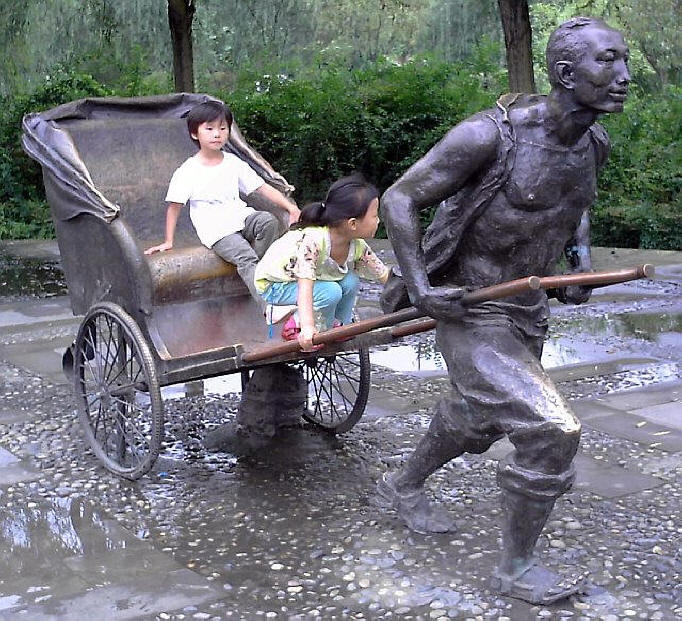
Leshan: Part of the scattered
sculpture garden in the Times Square Plaza.
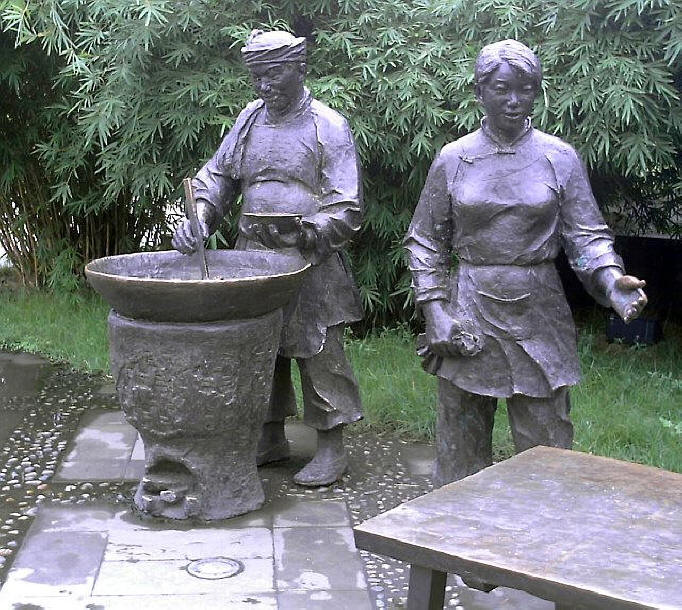
Leshan: Part of the scattered
sculpture garden in the Times Square Plaza.
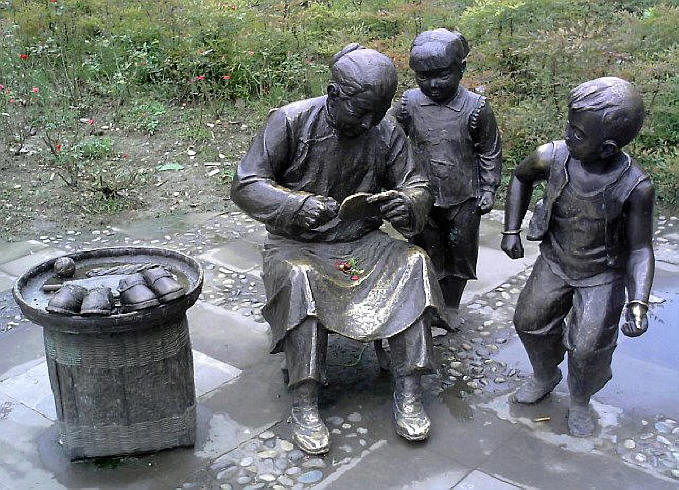
Leshan: Part of the scattered
sculpture garden in the Times Square Plaza.
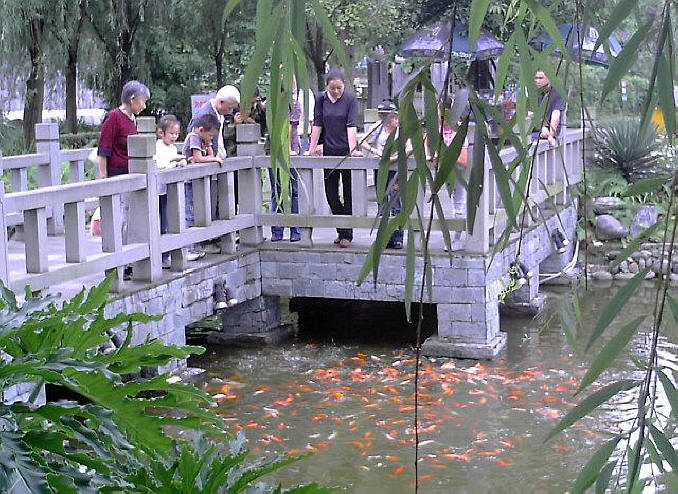
Leshan: People feeding the goldfish
along the zig-zag bridge across a pond in the Times Square Plaza.
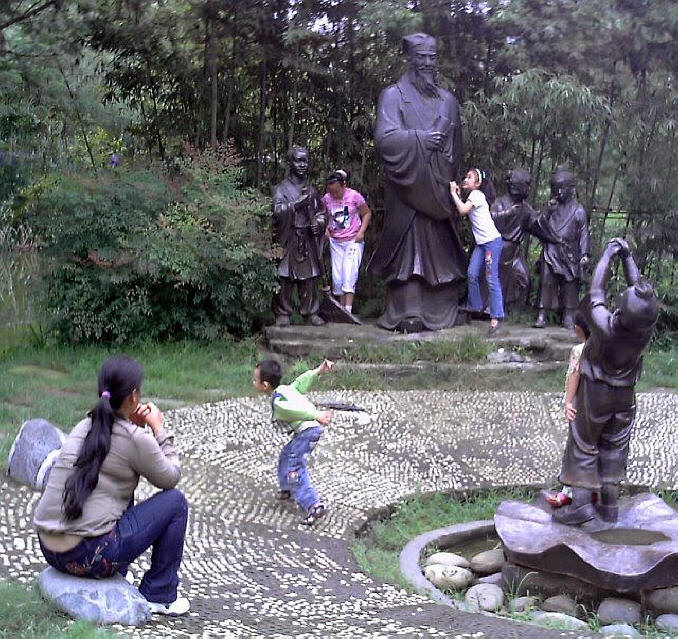
Leshan: Many works in the Times
Square Plaza sculpture garden serve as playgrounds for the kids and
photo backdrops for photographers.
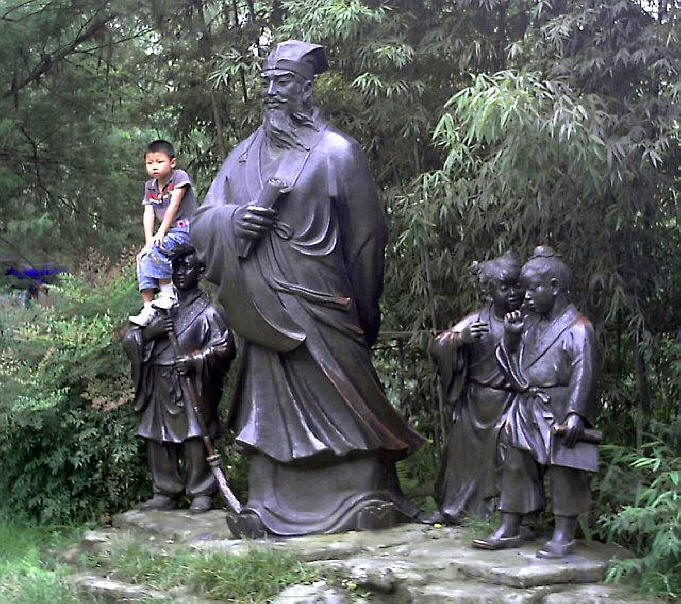
Leshan: Some of the scenes in the
sculpture garden may depict historical or legendary figures.
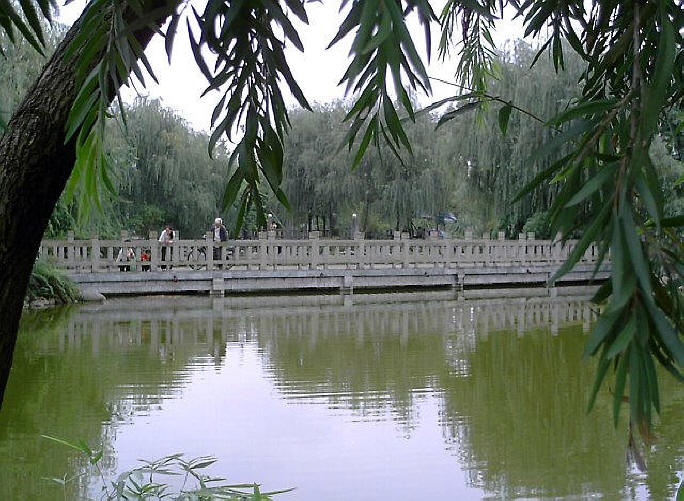
Leshan: Bridge across a pond in the
Times Square Plaza. friends.
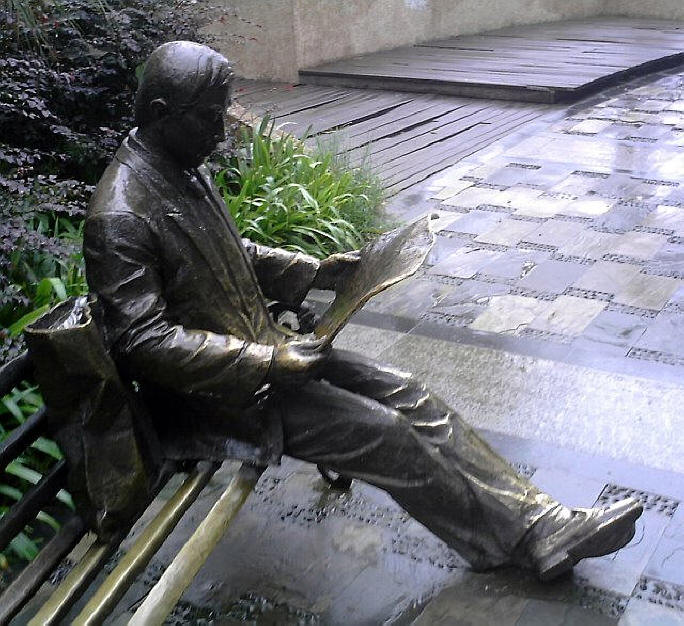
Leshan: In one of the many small parks
along the main street next to the river I found this fellow engrossed in
his newspaper.

Leshan: In one of the many small parks
along the main street next to the river I found this attractive
sculpture not far from another of a bronze guy reading a newspaper.
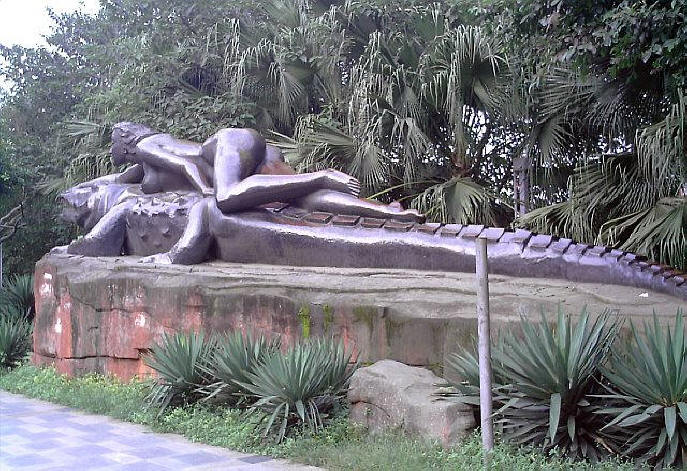
Leshan: Crocodile sculpture in a small
park along one of the principle streets through town.
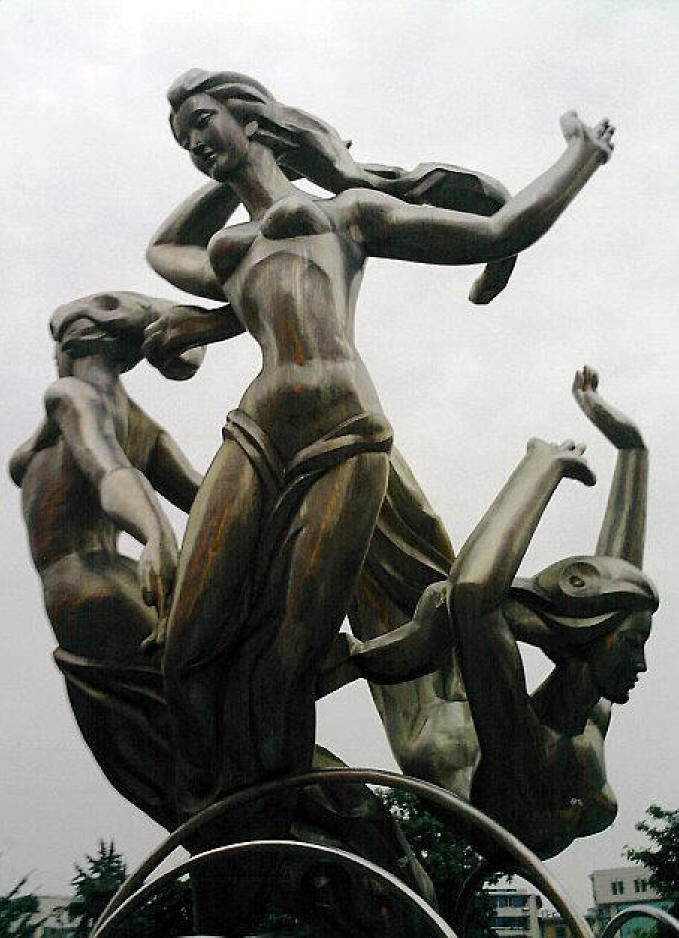
Leshan: This sculpture dominates the
center of a traffic circle near the hotel.

Leshan: Melon on a stick is a popular
snack along the main street and one sees many carts like this one.
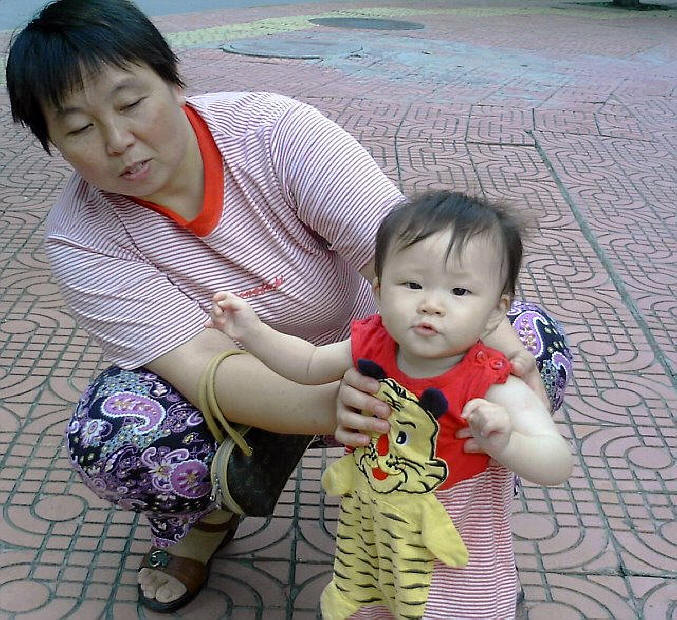
Leshan: Granny insists her little charge
perform for the foreign stranger... for which the tyke needed no
encouragement. I found the tiny tot's playfulness captivating and could
hardly pull myself away from the performance with grandma egging the kid
on to more of the cutest antics I've witnesses so far.
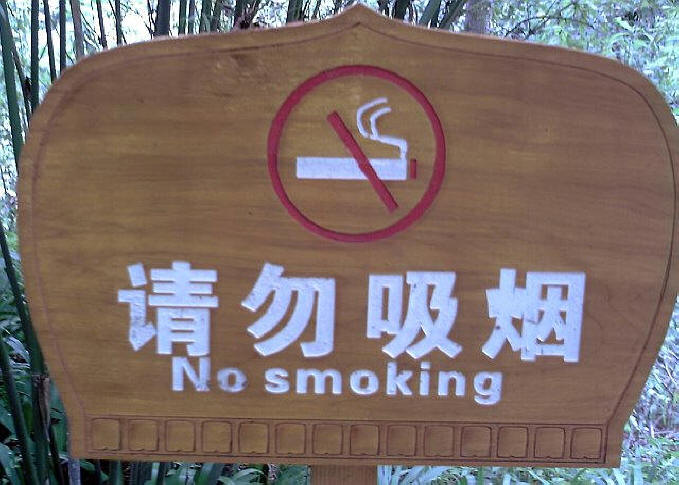
Leshan: Smoking is prohibited in many places
throughout the park. Still, one sees plenty of cigarette butts on the
ground, so not everyone can control their addiction.
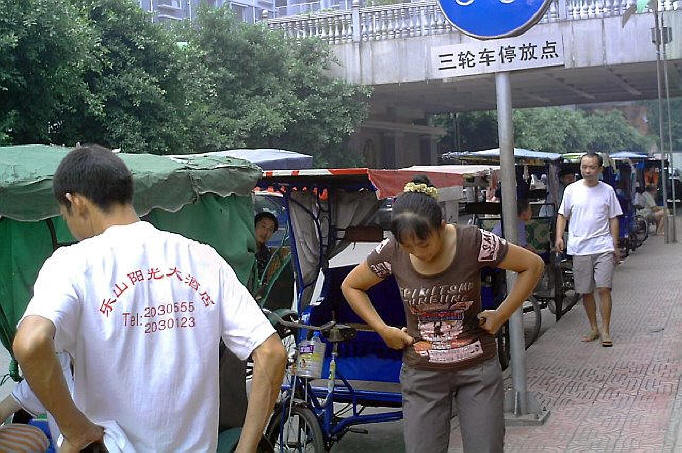
Leshan: Queues of rickshaws like this, line the
street curbs near any popular shopping location. They compete with one Yuan
buses, 2-5 Yuan four wheel taxis, 1-3 Yuan motorcycle taxis... and of course
free walking which I usually chose for all but the most distant
destinations.
|
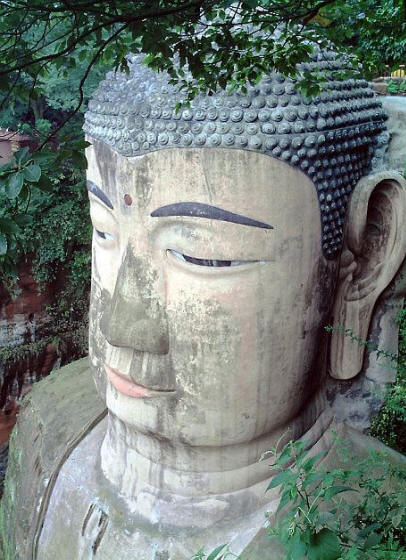
Leshan: Head of the Leshan Giant Buddha
statue, a 200 foot high work carved into the red sand stone cliff rising up
out of the Dadu River waters.
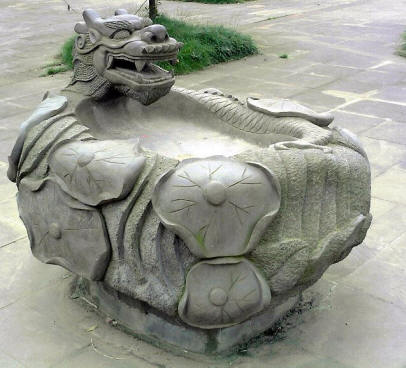
Leshan: Erected in the assembly area around
the North entrance to the Buddha Cultural area where the Giant Buddha statue
is located is this Chinese "baptismal fount." If the healing waters don't
wash your sins away, the dragon is sure to scare the hell out of you.
Actually, its real use is a mystery to me.
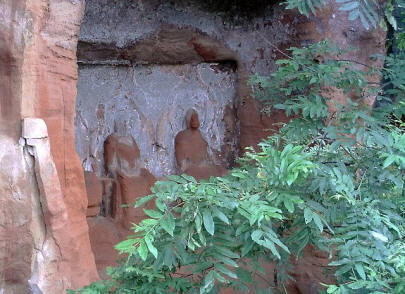
Leshan: The cliff walls facing the assembly
area around the North entrance to the Buddha Cultural area where the Giant
Buddha statue is located are pocked with ancient sculptures, most of which
have weathered so much it is difficult to see the original intention.
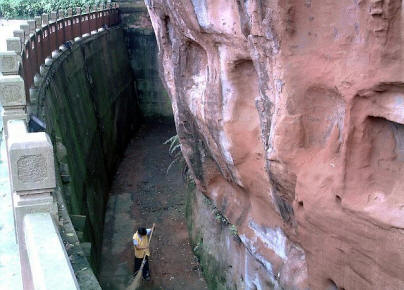
Leshan: These cliff walls facing the assembly
area around the North entrance to the Buddha Cultural area are now partially
below street level.
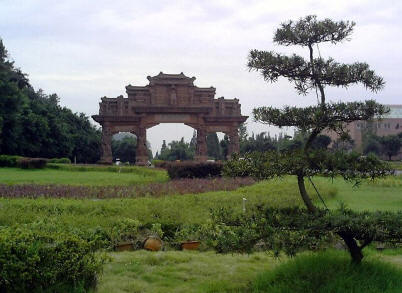
Leshan: That is the main gate into the Buddha
Cultural Park. It is called the Giant Buddha Torii.
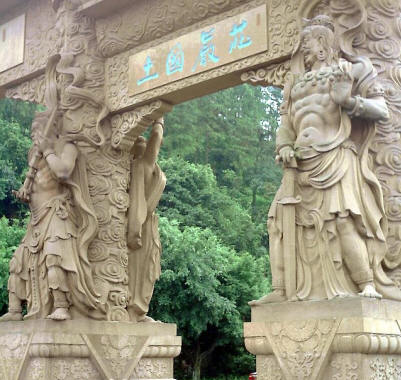
Leshan: Details of the main gate into the
Buddha Cultural Park. It is called the Giant Buddha Torii.
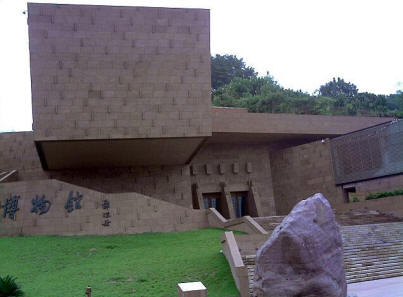
Leshan: This is the Leshan Giant Buddha
Museum. It seems to have been abandoned, but I found the architecture
particularly appealing.

Leshan: Plaque designating the park as a
World Heritage Site.
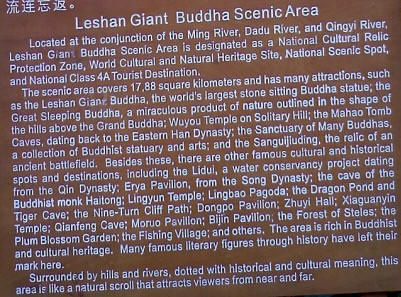
Leshan: Plaque containing historical
information about the park.
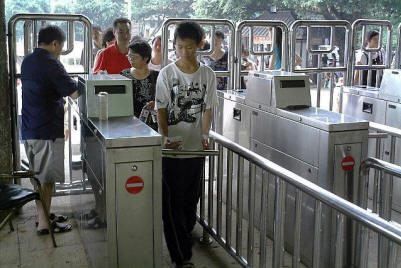
Leshan: North gate entrance. Oldsters over 70
years of age enter free. Others pay 50 Yuan, about $7.50. It pays to live a
long time in China.

Leshan: The Giant Buddha statue is located
just around that cliff. One of the tourist boats is slowing as it passes the
place where passengers can get the best view of the enormous sculpture.
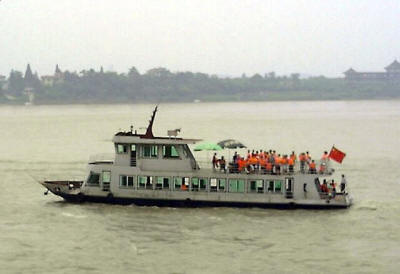
Leshan: One of the tourist boats slows as it
passes the place where passengers can get the best view of the Giant Buddha
.
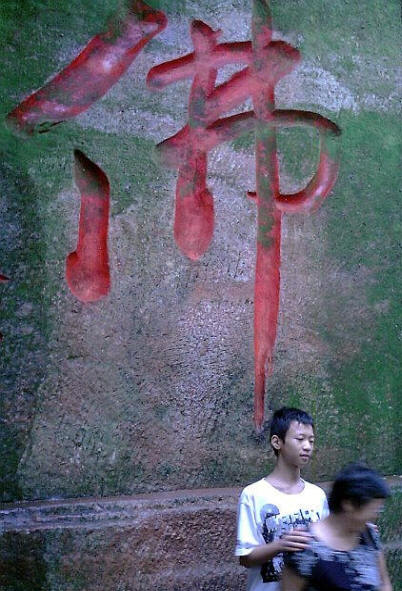
Leshan:
Shortly after entering the North Gate we are faced with a cave and the
beginning of the stone stairs leading up to the top of the head of the
Leshan Giant Buddha statue. This spot is a favorite backdrop for photos.
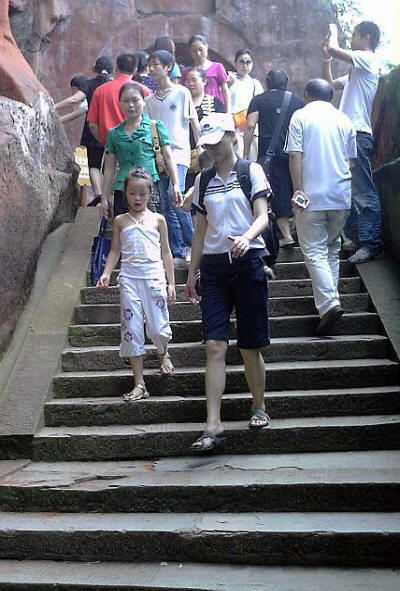
Leshan: Most of the hiking trail is well
engineered with frequent flights of shallow stone stairs like these. It is a
climb to the top, but nothing like Huashan!

Leshan: Many smaller sculptures of venerated
personages have been erected along the hiking trail leading up to the top of
the Giant Buddha's head.

Leshan: Sign along the hiking trail.

Leshan: Buddhist sayings have been chiseled
into the walls along the hiking trail leading up to the top of the Giant
Buddha's head.
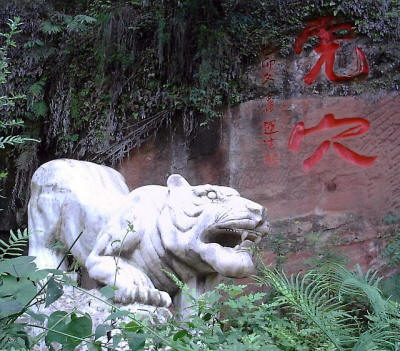
Leshan: Stone tiger statue guards the
entrance to a cave known as the Tiger's Lair where one of the revered monks
spent his quiet hours. I crawled into the cave and watching a family with
small children hesitate to climb up. I then mischievously let out a blood
curdling roar that delighted all.
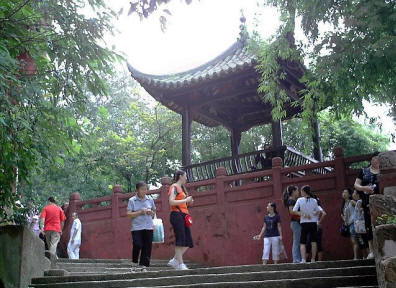
Leshan: Drinking Pavilion near the top of the
hill where the Giant Buddha head first becomes visible.
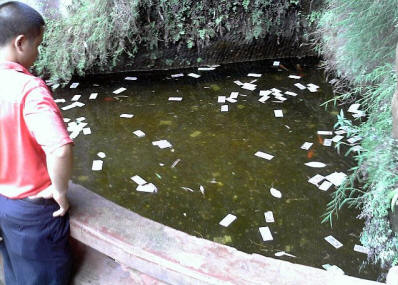
Leshan: Wishing well, Chinese style. People
throw paper money into this pond for reasons unknown: probably for the same
reason we toss coins into them, superstition I guess.

Leshan: Thousands of tourists and a few
religious pilgrims visit the cultural relics in this Buddhist Cultural Park
daily.
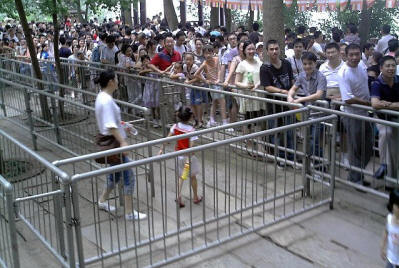
Leshan: These people are waiting to climb
down the steep stairway to the foot of the Giant Buddha.
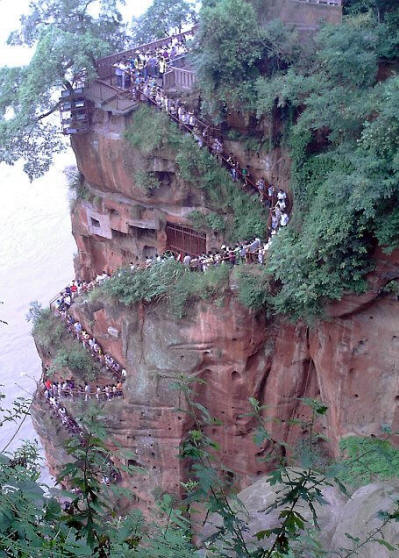
Leshan: People on the long steep stone
stairway down to the viewing platform at the base of the Giant Buddha statue
as seen from the head of the Giant Buddha.
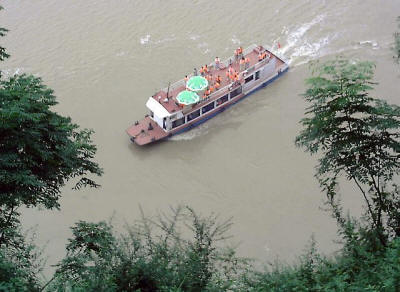
Leshan: Looking down on another tourist boat
on its way to the base of the Giant Buddha.
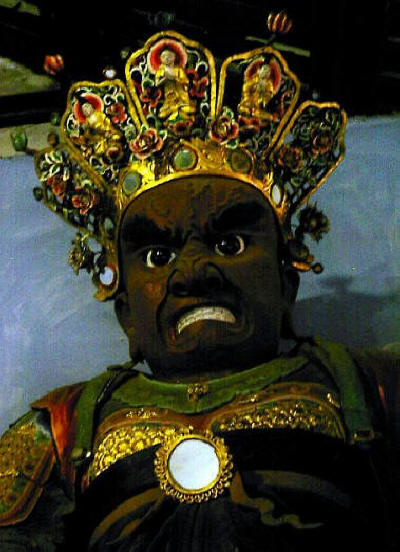
Leshan: One of the terrible mythical
guardians at the gate into a temple area.
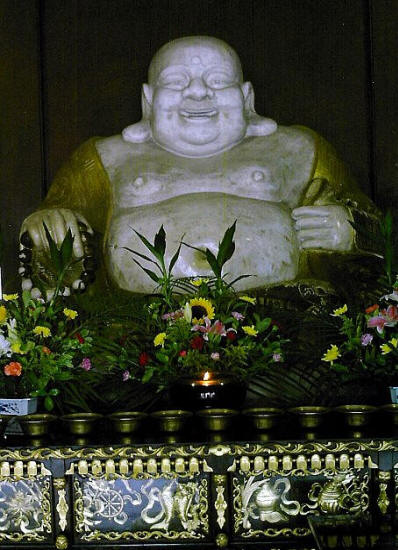
Leshan: This Fat Buddha sits next to the
guardians.

Leshan: One of the other mythical guardians
at the gate into a temple area.
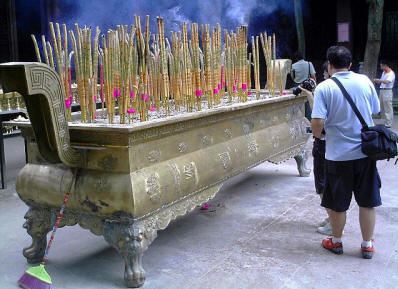
Leshan: Pilgrims light incense sticks at the
entrance into a temple area.
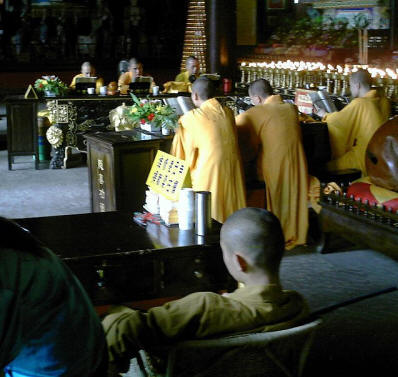
Leshan: A group of "monks" chant the Buddhist
sutras in one of the temples. Actually, all these guys are now paid by the
central government to "perform" the ancient rituals for the edification of
tourists. However, some may also be devoted monks as well.
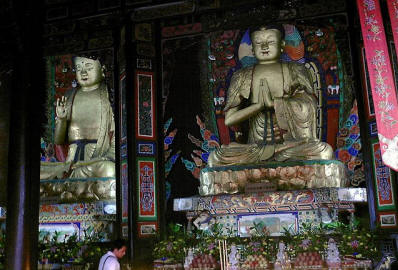
Leshan: Statues of other Buddhas in the
chamber where a group of "monks" chant the Buddhist sutras.

Leshan: Visitors on the way to viewing the
giant head pass the entrance to the temple where a group of "monks" chant
the Buddhist sutras, adding greatly to the sacred ambiance of the area for a
few of us oldsters.
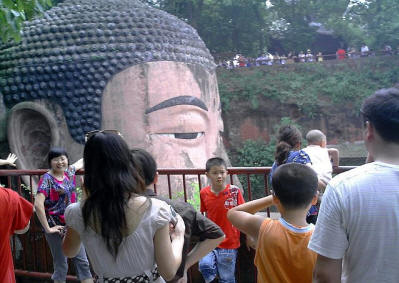
Leshan: Finally at the top of the hill I come
upon the actual head of the Leshan Giant Buddha. I am joined by crowds of
noisy families, children running and screaming like it is recess time in
school. The atmosphere is jubilant, few reverent pilgrims in this gang.
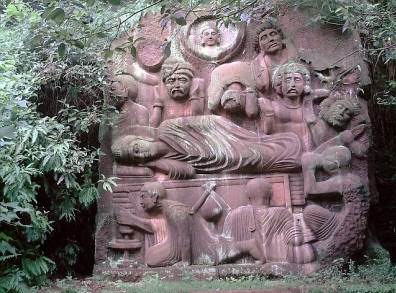
Leshan: Bas relief sculpture at the bottom of
the wide stairway.
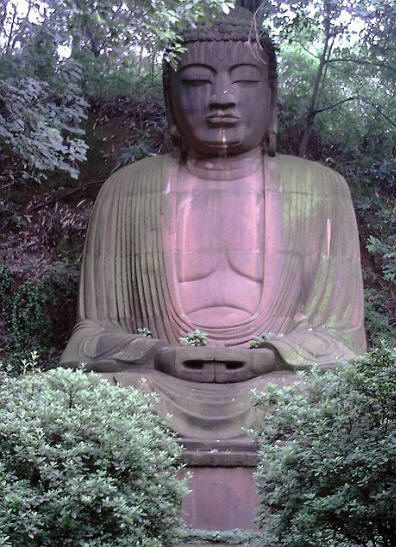
Leshan: Another Buddha sculpture at the
bottom of the wide stairway.

Leshan: Another Buddha sculpture at the
bottom of the wide stairway. This one reminds me of monuments I saw at
Angkor Wat in Cambodia.
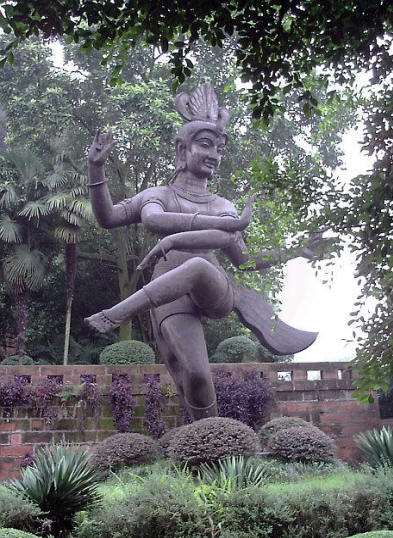
Leshan: Sculpture at the bottom of the wide
stairway.
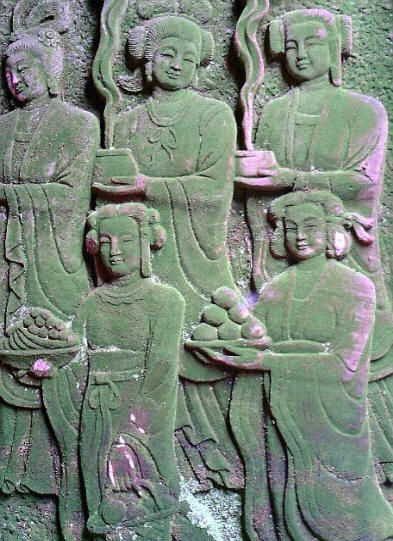
Leshan: Bas relief sculpture at the bottom of
the wide stairway.

Leshan: Sculpture at the bottom of the wide
stairway near the obscure giant reclining bas relief sculpture.
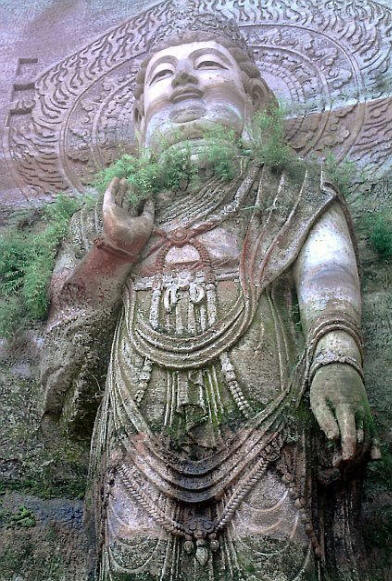
Leshan: Sculpture at the bottom of the wide
stairway.
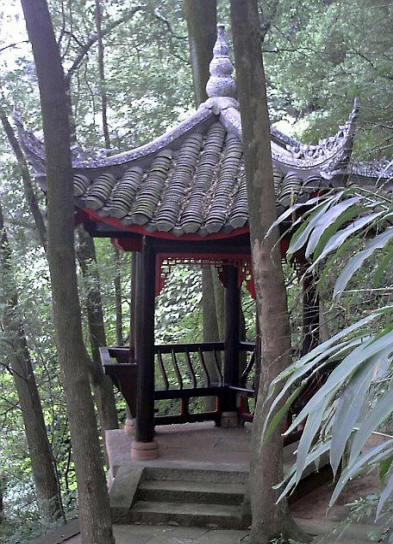
Leshan: I love these little "gazebos" located
where people most need to rest.
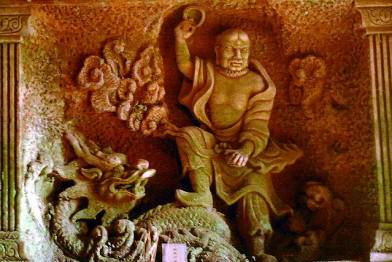
Leshan: Monk and dragon sculpture at the
bottom of the wide stairway.
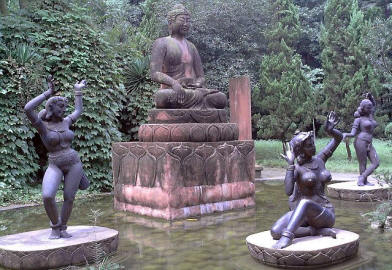
Leshan: Group sculpture at the bottom of the
wide stairway.
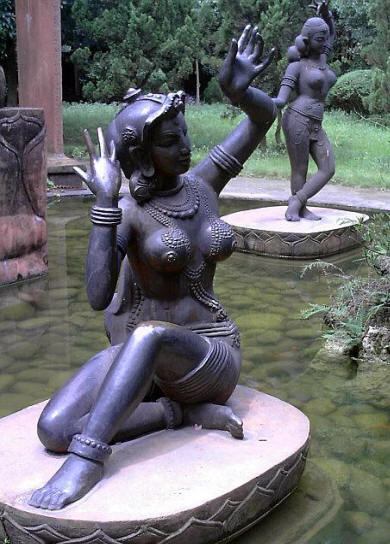
Leshan: Close up of a female dancer as part
of the group sculpture at the bottom of the wide stairway.
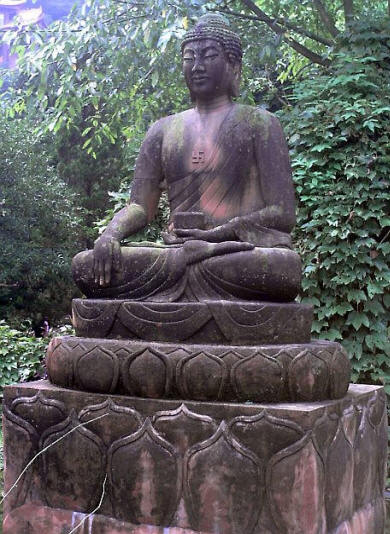
Leshan: Seated Buddha sculpture at the bottom
of the wide stairway.
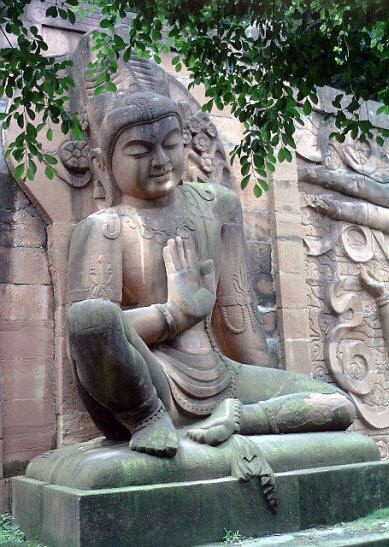
Leshan: Part of the sculpture garden located
off to the side at thee bottom of the wide stairway.
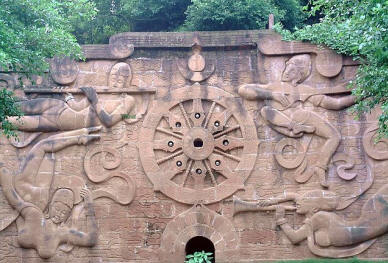
Leshan: Musicians bas relief in the sculpture
garden located off to the side at thee bottom of the wide stairway.
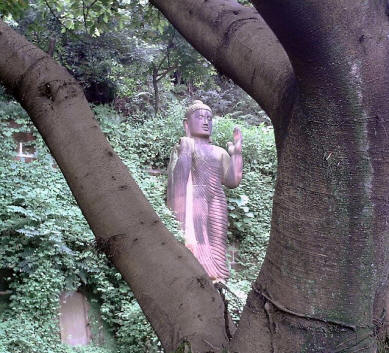
Leshan: Isolated standing Buddha in the
sculpture garden located off to the side at the bottom of the wide stairway.

Leshan: Dancer in the trees off to the side at
the bottom of the wide stairway.
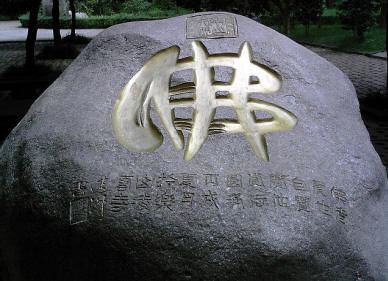
Leshan: Large engraving on a huge boulder.
Have no idea what it says, but I found it beautiful.
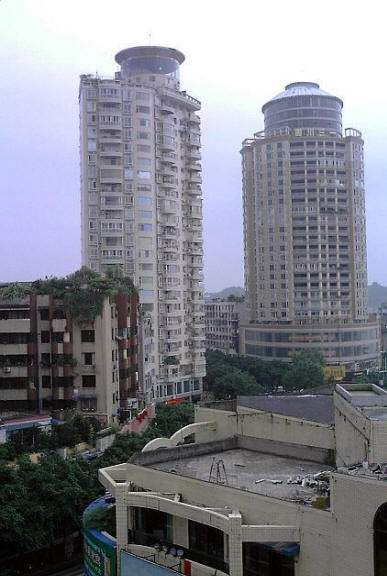
Leshan: City view as seen from my eighth
floor room in the Jia Zhou Hotel.
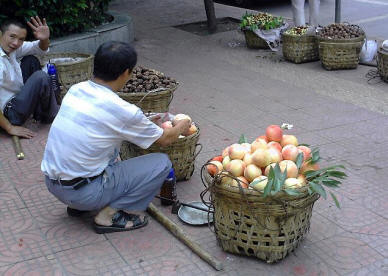
Leshan: One of the street venders working
near the hotel selling delicious peaches with the texture of apples!
Crunchy, but wonderfully sweet, I thought they must be unripe until I bit
into one of them.

Leshan: One of the finished paper decorations
used in store openings and other important events.

Leshan: Locals who enjoy floating down the
river congregate at the jumping off place on one of the river wharfs. Some
carry dry clothes in large red floating bags secured by a lanyard to their
bodies.
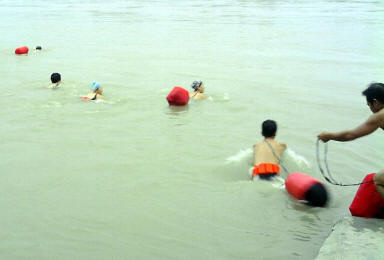
Leshan: River swimmers-floaters leave the
wharf one after another, first swimming hard out to the faster currents in
the middle of the river.
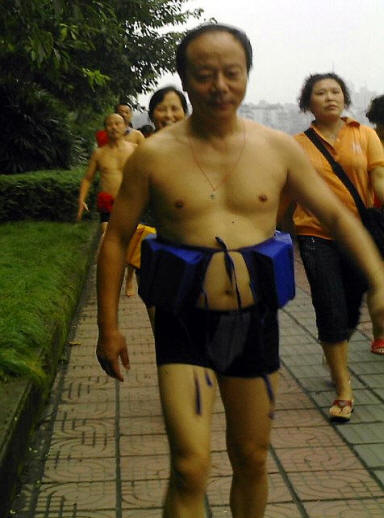
Leshan: When the swim-float is over some hike
several kilometers back up the riverside walk to do it all over again. These
guys obviously relish the invigorating exercise. From my window in the hotel
I watched as an enormous crowd in bathing suits filled one of the buses to
quicken the trip back up stream to have another run at the river.

Leshan: Near the Western Bus Terminal I found
extensive housing developments. Each contained its own compact shopping
complex. This is the entrance to the A Little Flavor Restaurant where I
enjoyed several "box" lunches.

Leshan: This is a manhole cover! The last
Chinese symbol is the one found in the names of all WongBa's, Internet
Cafes/Bars. I had to wonder if there might be an Internet terminal hidden
down in the hole!

Leshan: While walking West along the river
road I stopped to inspect the herbal offerings of a street vendor. These two
girls approached offering translation help. The one on the right is Dinah;
the one on the left hasn't yet received her English name from a teacher.
Dinah is a bright twenty year old college freshman who wants to study
mathematics. We spoke for a half hour.
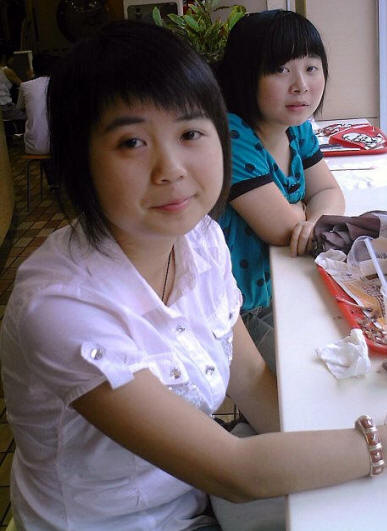
Leshan: Chewing on my KFC chicken the
older of these two sister started chatting with me in English. As we talked it became obvious
this 19 year old college freshman majoring in English had mastered
her foreign language. Her distinctive accent clearly marked her as a
non-native speaker, but complex ideas and sentence construction
impressed me with her proficiency. Majoring in English, she does not
want to become a teacher like the majority of her classmates; she
will become an administrator. As she had not yet been given an
English name, she begged me to give her one. I chose Sandra as it
has sounds in common with her Chinese name. For the next ten minutes
she insisted I tell her everything I knew about the meaning of the
name Sandra ; I didn't have a clue! Later I checked
Wikipedia.
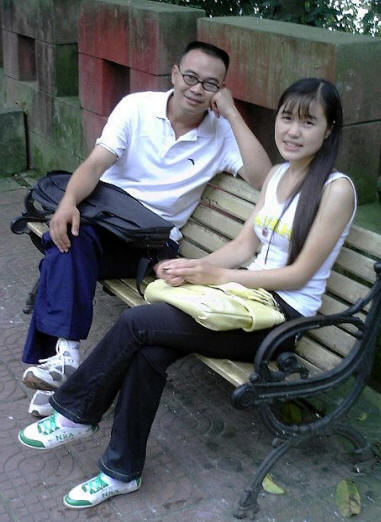
Leshan: Walking East along the river walk I
ran into this couple who wanted to chat in English. More mature than most of
the kids I encounter, we actually exchanged some meaningful information.

Leshan: These kids behaved overjoyed in being
able to converse with an actual English speaking visitor. I found their
enthusiasm contagious.
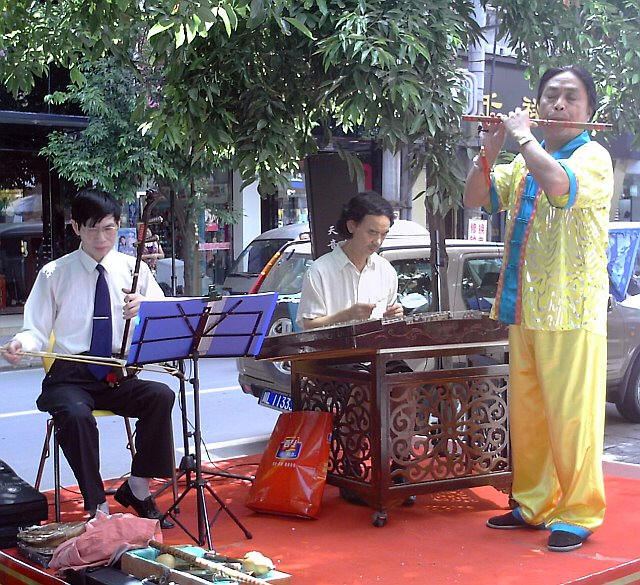
Leshan: Musicians attracting
attention to a seller of Moon Cakes on the streets of downtown
Leshan. |



